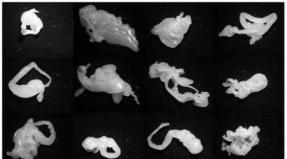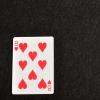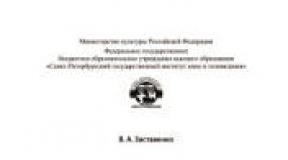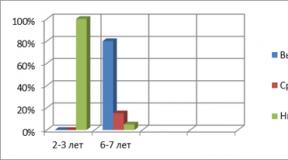D50 Iron deficiency anemia. Symptoms, causes and treatment of iron deficiency anemia Anemia, unspecified by microbiology 10
Search by code ICD-10
Classes of diseases ICD-10
hide all | reveal everything
International Statistical Classification of Diseases and Related Health Problems.
Iron deficiency anemia (D50)
Included: anemia:
- sideropenic
- hypochromic
In Russia International classification diseases of the 10th revision (ICD-10) was adopted as a single normative document to take into account the incidence, the reasons for the population's appeals to medical institutions of all departments, and the causes of death.
ICD-10 was introduced into health care practice throughout the Russian Federation in 1999 by order of the Ministry of Health of Russia dated 05/27/97. No. 170
A new revision (ICD-11) is planned by WHO in 2017 2018.
As amended and supplemented by WHO
Processing and translation of changes © mkb-10.com
ICD 10. Class III (D50-D89)
ICD 10. Class III. Diseases of the blood, blood-forming organs and certain disorders involving the immune mechanism (D50-D89)
Excludes: autoimmune disease (systemic) NOS (M35.9), certain conditions arising in the perinatal period (P00-P96), complications of pregnancy, childbirth and the puerperium (O00-O99), congenital anomalies, deformities and chromosomal abnormalities (Q00- Q99), endocrine diseases, nutritional and metabolic disorders (E00-E90), disease caused by the human immunodeficiency virus [HIV] (B20-B24), trauma, poisoning and some other consequences of exposure external causes(S00-T98), neoplasms (C00-D48), symptoms, signs and abnormal clinical and laboratory findings, not elsewhere classified (R00-R99)
This class contains the following blocks:
D50-D53 Nutritional anemias
D55-D59 Hemolytic anemias
D60-D64 Aplastic and other anemias
D65-D69 Blood clotting disorders, purpura and other hemorrhagic conditions
D70-D77 Other diseases of the blood and hematopoietic organs
D80-D89 Certain disorders involving the immune mechanism
The following categories are marked with an asterisk:
D77 Other disorders of blood and hematopoietic organs in diseases classified elsewhere
Diet-related anemias (D50-D53)
D50 Iron deficiency anemia
D50.0 Iron deficiency anemia secondary to blood loss (chronic) Posthemorrhagic (chronic) anemia.
Excludes: acute posthemorrhagic anemia(D62) congenital anemia due to fetal hemorrhage (P61.3)
D50.1 Sideropenic dysphagia Kelly-Paterson syndrome. Plummer-Vinson syndrome
D50.8 Other iron deficiency anemias
D50.9 Iron deficiency anemia, unspecified
D51 Vitamin B12 deficiency anemia
Excludes: vitamin B12 deficiency (E53.8)
D51.0 Vitamin B12 deficiency anemia due to intrinsic factor deficiency.
Congenital insufficiency of intrinsic factor
D51.1 Vitamin B12 deficiency anemia due to selective malabsorption of vitamin B12 with proteinuria.
Imerslund (-Gresbeck) syndrome. Megaloblastic hereditary anemia
D51.2 Transcobalamin II deficiency
D51.3 Other dietary vitamin B12 deficiency anemias. Vegetarian anemia
D51.8 Other vitamin B12 deficiency anemias
D51.9 Vitamin B12 deficiency anemia, unspecified
D52 Folic acid deficiency anemia
D52.0 Nutritional folate deficiency anemia Megaloblastic alimentary anemia
D52.1 Drug-induced folate deficiency anemia If necessary, identify medicine
use an additional external reason code (class XX)
D52.8 Other folate deficiency anemias
D52.9 Unspecified folate deficiency anemia Anemia due to inadequate intake folic acid, NOS
D53 Other nutritional anemias
Includes: megaloblastic anemia, refractory vitamin
nom B12 or folate
D53.0 Protein deficiency anemia Anemia due to amino acid deficiency.
Excludes1: Lesch-Nyhan syndrome (E79.1)
D53.1 Other megaloblastic anemias, not elsewhere classified. Megaloblastic anemia NOS.
Excludes: Di Guglielmo's disease (C94.0)
D53.2 Anemia due to scurvy
Excludes2: scurvy (E54)
D53.8 Other specified nutritional anemias
Deficiency Anemia:
Excludes: malnutrition without mention of
anemias such as:
Copper deficiency (E61.0)
Molybdenum deficiency (E61.5)
Zinc deficiency (E60)
D53.9 Nutritional anemia, unspecified Simple chronic anemia.
Excludes1: anemia NOS (D64.9)
HEMOLYTIC ANEMIAS (D55-D59)
D55 Anemia due to enzyme disorders
Excludes1: drug-induced enzyme deficiency anemia (D59.2)
D55.0 Anemia due to deficiency of glucose-6-phosphate dehydrogenase [G-6-PD]. Favism. G-6-PD deficiency anemia
D55.1 Anemia due to other disorders of glutathione metabolism
Anemia due to enzyme deficiency (with the exception of G-6-PD) associated with hexose monophosphate [HMP]
a shunt of the metabolic pathway. Hemolytic non-spherocytic anemia (hereditary) type 1
D55.2 Anemia due to disorders of glycolytic enzymes
Hemolytic non-spherocytic (hereditary) type II
Due to the lack of hexokinase
Due to the lack of pyruvate kinase
Due to the lack of triose phosphate isomerase
D55.3 Anemia due to abnormalities in nucleotide metabolism
D55.8 Other anemias due to enzyme disorders
D55.9 Anemia due to enzyme disorder, unspecified
D56 Thalassemia
Excludes1: dropsy of fetus due to hemolytic disease (P56.-)
D56.1 Beta thalassemia. Cooley's anemia. Severe beta thalassemia. Sickle cell beta thalassemia.
D56.3 Carriage of sign of thalassemia
D56.4 Hereditary persistence of fetal hemoglobin [NPFH]
D56.9 Thalassemia, unspecified Mediterranean anemia (with other hemoglobinopathy)
Thalassemia (minor) (mixed) (with other hemoglobinopathy)
D57 Sickle cell disorders
Excludes: other hemoglobinopathies (D58.-)
sickle cell beta thalassemia (D56.1)
D57.0 Sickle cell anemia with crisis. Hb-SS disease with crisis
D57.1 Sickle cell anemia without crisis.
D57.2 Double heterozygous sickle cell disorders
D57.3 Carriage of sickle cell trait. Carriage of hemoglobin S. Heterozygous hemoglobin S
D57.8 Other sickle cell disorders
D58 Other hereditary hemolytic anemias
D58.0 Hereditary spherocytosis Aholuric (familial) jaundice.
Congenital (spherocytic) hemolytic jaundice. Minkowski-Shoffard syndrome
D58.1 Hereditary elliptocytosis Ellithocytosis (congenital). Ovalocytosis (congenital) (hereditary)
D58.2 Other hemoglobinopathies Abnormal hemoglobin NOS. Congenital anemia with Heinz bodies.
Hemolytic disease caused by unstable hemoglobin. Hemoglobinopathy NOS.
Excludes: familial polycythemia (D75.0)
Hb-M disease (D74.0)
hereditary persistence of fetal hemoglobin (D56.4)
polycythemia associated with height (D75.1)
D58.8 Other specified hereditary hemolytic anemias Stomatocytosis
D58.9 Hereditary hemolytic anemia unspecified
D59 Acquired hemolytic anemia
D59.0 Drug-induced autoimmune hemolytic anemia.
If it is necessary to identify a medicinal product, an additional code of external causes (class XX) is used.
D59.1 Other autoimmune hemolytic anemias Autoimmune hemolytic disease (cold type) (heat type). Chronic disease caused by cold hemagglutinins.
Cold type (secondary) (symptomatic)
Thermal type (secondary) (symptomatic)
Excludes: Evans syndrome (D69.3)
hemolytic disease of fetus and newborn (P55 .-)
paroxysmal cold hemoglobinuria (D59.6)
D59.2 Drug-induced non-autoimmune hemolytic anemia Drug enzyme deficiency anemia.
If it is necessary to identify a medicinal product, an additional code of external causes (class XX) is used.
D59.3 Hemolytic uremic syndrome
D59.4 Other non-autoimmune hemolytic anemias
If it is necessary to identify the cause, an additional external cause code (class XX) is used.
D59.5 Paroxysmal nocturnal hemoglobinuria[Markiafava-Mikeli].
D59.6 Hemoglobinuria due to hemolysis due to other external causes.
Excludes: hemoglobinuria NOS (R82.3)
D59.8 Other acquired hemolytic anemias
D59.9 Acquired hemolytic anemia, unspecified Chronic idiopathic hemolytic anemia
APLASTIC AND OTHER ANEMIAS (D60-D64)
D60 Acquired pure red cell aplasia (erythroblastopenia)
Includes: red cell aplasia (acquired) (adults) (with thymoma)
D60.0 Chronic acquired pure red cell aplasia
D60.1 Transient acquired pure red cell aplasia
D60.8 Other acquired pure red cell aplasias
D60.9 Acquired pure red cell aplasia, unspecified
D61 Other aplastic anemias
Excludes: agranulocytosis (D70)
D61.0 Constitutional aplastic anemia
Aplasia (pure) red cell:
Blackfen-Daymond syndrome. Familial hypoplastic anemia. Fanconi's anemia. Pancytopenia with malformations
D61.1 Drug-induced aplastic anemia If necessary, identify the medicinal product
use an additional external cause code (class XX).
D61.2 Aplastic anemia due to other external agents
If it is necessary to identify the cause, an additional external cause code (class XX) is used.
D61.3 Idiopathic aplastic anemia
D61.8 Other specified aplastic anemias
D61.9 Aplastic anemia, unspecified Hypoplastic anemia NOS. Hypoplasia bone marrow... Panmieloftiz
D62 Acute posthemorrhagic anemia
Excludes1: congenital anemia due to fetal hemorrhage (P61.3)
D63 Anemia in chronic diseases classified elsewhere
D63.0 Anemia in neoplasms (C00-D48 +)
D63.8 Anemia in others chronic diseases classified elsewhere
D64 Other anemias
Excludes: refractory anemia:
With excess blasts (D46.2)
With transformation (D46.3)
With sideroblasts (D46.1)
Without sideroblasts (D46.0)
D64.0 Hereditary sideroblastic anemia Sex-related hypochromic sideroblastic anemia
D64.1 Secondary sideroblastic anemia due to other diseases.
If it is necessary to identify the disease, an additional code is used.
D64.2 Secondary sideroblastic anemia due to drugs or toxins.
If it is necessary to identify the cause, an additional external cause code (class XX) is used.
D64.3 Other sideroblastic anemias
Pyridoxine-responsive, not elsewhere classified
D64.4 Congenital dyserythropoietic anemia Dyshemopoietic anemia (congenital).
Excludes: Blackfen-Daymond syndrome (D61.0)
Di Guglielmo's disease (C94.0)
D64.8 Other specified anemias Children's pseudo leukemia. Leukoerythroblastic anemia
BLOOD COLLABILITY DISORDERS, PURPLE AND OTHER
HEMORRHAGIC CONDITIONS (D65-D69)
D65 Disseminated intravascular coagulation [defibrination syndrome]
Acquired afibrinogenemia. Consumption coagulopathy
Diffuse or disseminated intravascular coagulation
Fibrinolytic bleeding acquired
Excludes: defibrination syndrome (complicating):
In newborn (P60)
D66 Hereditary factor VIII deficiency
Factor VIII deficiency (functional impairment)
Excludes1: factor VIII deficiency with vascular disorder (D68.0)
D67 Hereditary factor IX deficiency
Factor IX (functional impairment)
Plasma thromboplastic component
D68 Other coagulation disorders
Abortion, ectopic or molar pregnancy (O00-O07, O08.1)
Pregnancy, childbirth and postpartum period(O45.0, O46.0, O67.0, O72.3)
D68.0 von Willebrand disease Angiohemophilia. Factor VIII deficiency with vascular impairment. Vascular hemophilia.
Excludes: hereditary capillary fragility (D69.8)
factor VIII deficiency:
With functional impairment (D66)
D68.1 Hereditary factor XI deficiency Hemophilia C. Deficiency of plasma thromboplastin precursor
D68.2 Hereditary deficiency of other coagulation factors Congenital afibrinogenemia.
Dysfibrinogenemia (congenital) Hypoproconvertinemia. Ovren's disease
D68.3 Hemorrhagic disorders due to anticoagulants circulating in the blood. Hyperheparinemia.
If it is necessary to identify the used anticoagulant, use an additional code of external causes
D68.4 Acquired coagulation factor deficiency
Clotting factor deficiency due to:
Vitamin K deficiency
Excludes1: vitamin K deficiency in newborn (P53)
D68.8 Other specified coagulation disorders Presence of an inhibitor of systemic lupus erythematosus
D68.9 Unspecified coagulation disorder
D69 Purpura and other hemorrhagic conditions
Excludes: benign hypergammaglobulinemic purpura (D89.0)
cryoglobulinemic purpura (D89.1)
idiopathic (hemorrhagic) thrombocythemia (D47.3)
lightning purpura (D65)
thrombotic thrombocytopenic purpura (M31.1)
D69.0 Allergic purpura
D69.1 Qualitative platelet defects Bernard-Soulier syndrome [giant platelets].
Glanzmann's disease. Gray platelet syndrome. Thrombastenia (hemorrhagic) (hereditary). Thrombocytopathy.
Excludes1: von Willebrand disease (D68.0)
D69.2 Other non-thrombocytopenic purpura
D69.3 Idiopathic thrombocytopenic purpura Evans Syndrome
D69.4 Other primary thrombocytopenias
Excludes: thrombocytopenia with absence of radius (Q87.2)
transient neonatal thrombocytopenia (P61.0)
Wiskott-Aldrich syndrome (D82.0)
D69.5 Secondary thrombocytopenia If it is necessary to identify the cause, an additional external cause code (class XX) is used.
D69.6 Thrombocytopenia, unspecified
D69.8 Other specified hemorrhagic conditions Capillary fragility (hereditary). Vascular pseudohemophilia
D69.9 Hemorrhagic condition, unspecified
OTHER DISEASES OF BLOOD AND HEMOROUS ORGANS (D70-D77)
D70 Agranulocytosis
Agranulocytic tonsillitis. Children's genetic agranulocytosis. Kostmann's disease
If it is necessary to identify the drug that caused neutropenia, use an additional external cause code (class XX).
Excludes: transient neonatal neutropenia (P61.5)
D71 Functional disorders of polymorphonuclear neutrophils
Defect in the receptor complex of the cell membrane. Chronic (children's) granulomatosis. Congenital dysphagocytosis
Progressive septic granulomatosis
D72 Other disorders of white blood cells
Excludes: basophilia (D75.8)
immune disorders (D80-D89)
preleukemia (syndrome) (D46.9)
D72.0 Genetic abnormalities of leukocytes
Anomaly (granulation) (granulocyte) or syndrome:
Excludes: Chédiak-Higashi (-Steinbrink) syndrome (E70.3)
D72.8 Other specified disorders of white blood cells
Leukocytosis. Lymphocytosis (symptomatic). Lymphopenia. Monocytosis (symptomatic). Plasmacytosis
D72.9 Disorder of white blood cells, unspecified
D73 Diseases of the spleen
D73.0 Hyposplenism Postoperative asplenia. Spleen atrophy.
Excludes1: asplenia (congenital) (Q89.0)
D73.2 Chronic congestive splenomegaly
D73.5 Spleen infarction The rupture of the spleen is non-traumatic. Twisting of the spleen.
Excludes1: traumatic rupture of spleen (S36.0)
D73.8 Other diseases of the spleen Fibrosis of the spleen NOS. Perisplenitis. Splenitis NOS
D73.9 Disease of spleen, unspecified
D74 Methemoglobinemia
D74.0 Congenital methemoglobinemia Congenital deficiency of NADH-methemoglobin reductase.
Hemoglobinosis M [Hb-M disease]. Methemoglobinemia hereditary
D74.8 Other methemoglobinemias Acquired methemoglobinemia (with sulfhemoglobinemia).
Toxic methemoglobinemia. If it is necessary to identify the cause, an additional external cause code (class XX) is used.
D74.9 Methemoglobinemia, unspecified
D75 Other diseases of blood and hematopoietic organs
Excluded: increase lymph nodes(R59. -)
hypergammaglobulinemia NOS (D89.2)
Mesenteric (acute) (chronic) (I88.0)
Excludes: hereditary ovalocytosis (D58.1)
D75.1 Secondary polycythemia
Decreased plasma volume
D75.2 Essential thrombocytosis
Excludes: essential (hemorrhagic) thrombocythemia (D47.3)
D75.8 Other specified diseases of the blood and hematopoietic organs Basophilia
D75.9 Disease of blood and hematopoietic organs, unspecified
D76 Certain diseases involving the lymphoreticular tissue and the reticulohistiocytic system
Excludes: Letterer-Siwe disease (C96.0)
malignant histiocytosis (C96.1)
reticuloendotheliosis or reticulosis:
Histiocytic medullary (C96.1)
D76.0 Langerhans cell histiocytosis, not elsewhere classified Eosinophilic granuloma.
Hand-Schüller-Krisgen disease. Histiocytosis X (chronic)
D76.1 Hemophagocytic lymphohistiocytosis Familial hemophagocytic reticulosis.
Histiocytosis from mononuclear phagocytes other than Langerhans cells, NOS
D76.2 Hemophagocytic syndrome associated with infection.
If it is necessary to identify an infectious agent or disease, an additional code is used.
D76.3 Other histiocytosis syndromes Reticulohistiocytoma (giant cell).
Sinus histiocytosis with massive lymphadenopathy. Xanthogranuloma
D77 Other disorders of the blood and blood-forming organs in diseases classified elsewhere.
Fibrosis of the spleen in schistosomiasis [bilharziasis] (B65. -)
SEPARATE DISORDERS INVOLVING THE IMMUNE MECHANISM (D80-D89)
Includes: defects in the complement system, immunodeficiency disorders, excluding disease,
caused by the human immunodeficiency virus [HIV] sarcoidosis
Excludes: autoimmune diseases (systemic) NOS (M35.9)
functional disorders of polymorphonuclear neutrophils (D71)
human immunodeficiency virus [HIV] disease (B20-B24)
D80 Immunodeficiencies with predominantly antibody deficiency
D80.0 Hereditary hypogammaglobulinemia
Autosomal recessive agammaglobulinemia (Swiss type).
X-linked agammaglobulinemia [Bruton's] (growth hormone deficient)
D80.1 Nonfamilial hypogammaglobulinemia Agammaglobulinemia with B-lymphocytes carrying immunoglobulins. General agammaglobulinemia. Hypogammaglobulinemia NOS
D80.2 Electoral deficit immunoglobulin A
D80.3 Selective deficiency of immunoglobulin G subclasses
D80.4 Selective deficiency of immunoglobulin M
D80.5 Immunodeficiency with increased content immunoglobulin M
D80.6 Lack of antibodies with close to normal levels of immunoglobulins or with hyperimmunoglobulinemia.
Antibody deficiency with hyperimmunoglobulinemia
D80.7 Transient hypogammaglobulinemia of children
D80.8 Other immunodeficiencies with a predominant antibody defect. Kappa light chain deficiency
D80.9 Immunodeficiency with predominant antibody defect, unspecified
D81 Combined immunodeficiencies
Excludes1: autosomal recessive agammaglobulinemia (Swiss type) (D80.0)
D81.0 Severe combined immunodeficiency with reticular dysgenesis
D81.1 Severe combined immunodeficiency with low T and B cell count
D81.2 Severe combined immunodeficiency with low or normal content B cells
D81.3 Adenosine deaminase deficiency
D81.5 Purine nucleoside phosphorylase deficiency
D81.6 Deficiency of MHC class I molecules. Naked Lymphocyte Syndrome
D81.7 Deficiency of class II molecules of the major histocompatibility complex
D81.8 Other combined immunodeficiencies Biotin-dependent carboxylase deficiency
D81.9 Combined immunodeficiency, unspecified Severe combined immunodeficiency disorder NOS
D82 Immunodeficiencies associated with other significant defects
Excludes: atactic telangiectasia [Louis-Bar] (G11.3)
D82.0 Wiskott-Aldrich syndrome Immunodeficiency with thrombocytopenia and eczema
D82.1 Dee Georg's syndrome Pharyngeal diverticulum syndrome.
Aplasia or hypoplasia with immune deficiency
D82.2 Immunodeficiency with dwarfism due to short limbs
D82.3 Immunodeficiency due to an inherited defect caused by Epstein-Barr virus.
X-linked lymphoproliferative disease
D82.4 Hyperimmunoglobulin E syndrome
D82.8 Immunodeficiency associated with other specified significant defects
D82.9 Immunodeficiency associated with major defect, unspecified
D83 Common variable immunodeficiency
D83.0 Common variable immunodeficiency with predominant abnormalities in the number and functional activity of B cells
D83.1 Common variable immunodeficiency with a predominance of disorders of immunoregulatory T cells
D83.2 Common variable immunodeficiency with autoantibodies to B or T cells
D83.8 Other common variable immunodeficiencies
D83.9 Common variable immunodeficiency, unspecified
D84 Other immunodeficiencies
D84.0 Defect of functional antigen-1 of lymphocytes
D84.1 Defect in the complement system. C1 esterase inhibitor deficiency
D84.8 Other specified immunodeficiency disorders
D84.9 Immunodeficiency, unspecified
D86 Sarcoidosis
D86.1 Sarcoidosis of lymph nodes
D86.2 Sarcoidosis of the lungs with sarcoidosis of the lymph nodes
D86.8 Sarcoidosis of other specified and combined localizations. Iridocyclitis in sarcoidosis (H22.1).
Multiple cranial nerve palsies in sarcoidosis (G53.2)
Uveoparotic fever [Herfordt's disease]
D86.9 Sarcoidosis, unspecified
D89 Other disorders involving the immune mechanism, not elsewhere classified
Excludes: hyperglobulinemia NOS (R77.1)
monoclonal gammopathy (D47.2)
graft failure and rejection (T86 .-)
D89.0 Polyclonal hypergammaglobulinemia. Hypergammaglobulinemic purpura. Polyclonal gammopathy NOS
D89.2 Hypergammaglobulinemia, unspecified
D89.8 Other specified disorders involving the immune mechanism, not elsewhere classified
D89.9 Unspecified disorder involving the immune mechanism Immune disease NOS
ICD 10 coding for iron deficiency anemia
Differential diagnosis of anemic syndromes is an important part of patient management, since treatment approaches will differ depending on the pathogenesis.
That's why Iron-deficiency anemia according to ICD 10 it has a code D50, which distinguishes it from other types of this syndrome.
Separate chronic IDA are pathologies associated with intense blood loss, that is, appearing as a result of hemorrhagic syndrome, and IDA of primary genesis. The mechanism of development of hypochromic anemia without blood loss is associated with a lack of iron intake into the body, with immune processes that block its transformation or pathologies, due to which there is a malabsorption.
Hypochromic anemia is always accompanied by a lack of hemoglobin in erythrocytes, which includes iron.
Features of IDA
Anemic syndrome does not give specific manifestations, therefore, the mechanism of its development: lack of elements, problems of a hematopoietic nature, pronounced breakdown of erythrocytes - are determined by laboratory. In ICD 10, iron deficiency anemia is encoded by D50, which suggests the following diagnostic criteria:
- a decrease in the number of red blood cells;
- decrease in color index;
- decrease in the amount of hemoglobin;
- a low level of serum iron (with refractory anemia, the indicator, on the contrary, rises significantly).
V medical institutions individual protocols for the treatment of this disease are used. However, the IDA code implies general principles therapy based on iron preparations.
Classification of anemias according to mcb-x
D51 - vitamin B 12 - deficient;
D53 - Other nutritional anemias.
D55 - associated with enzymatic disorders;
D58-other hereditary hemolytic anemias;
D59-acute acquired hemolytic.
D60 - acquired red cell aplasia (erythroblastopenia);
D61-other aplastic anemias;
D62 - acute aplastic anemia;
D63-anemia of chronic diseases;
Pathogenesis
The supply of oxygen to tissues is provided by erythrocytes - blood cells that do not contain a nucleus, the main volume of an erythrocyte is occupied by hemoglobin - a protein that binds oxygen. The life span of erythrocytes is about 100 days. At a hemoglobin concentration lower / l, oxygen delivery to the kidneys decreases, this is a stimulus for the production of erythropoietin by the interstitial cells of the kidneys, this leads to the proliferation of cells of the erythroid lineage of the bone marrow. For normal erythropoiesis it is necessary:
healthy bone marrow
healthy kidneys that produce enough erythropoietin
sufficient content of substrate elements necessary for hematopoiesis (primarily iron).
Violation of one of these conditions leads to the development of anemia.
Figure 1. Scheme of the formation of erythrocytes. (T.R. Harrison).
Clinical picture
The clinical manifestations of anemia are determined by its severity, the rate of development, and the patient's age. Under normal conditions, oxyhemoglobin gives off only a small part of the oxygen bound to it to the tissues, the possibilities of this compensatory mechanism are great and with a decrease in Hb by 20-30 g / l, the release of oxygen to the tissues increases and there may be no clinical occurrence of anemia, anemia is often detected by a random blood test.
At a concentration of Hb below 70-80 g / l, fatigue appears, shortness of breath with physical activity, heartbeat, headache pulsating character.
In elderly patients with cardiovascular diseases, there is an increase in pain in the heart, an increase in signs of heart failure.
Acute blood loss leads to rapid decline the number of erythrocytes and BCC. It is necessary, first of all, to assess the state of hemodynamics. Redistribution of blood flow and venous spasm cannot compensate for acute blood loss of more than 30%. Such patients lie, there is a pronounced orthostatic hypotension, tachycardia. The loss of more than 40% of blood (2000 ml) leads to shock, the signs of which are tachypnea and tachycardia at rest, stunnedness, cold clammy sweat, and a decrease in blood pressure. An urgent restoration of the bcc is necessary.
In chronic bleeding, the BCC manages to recover on its own, a compensatory increase in the BCC develops and cardiac output... As a result, an increased apical impulse, a high pulse appear, pulse pressure increases, due to the accelerated flow of blood through the valve, systolic murmur is heard during auscultation.
The pallor of the skin and mucous membranes becomes noticeable with a decrease in the concentration of Hb dog / l. The appearance of jaundice can also be a sign of anemia. When examining the patient, attention is paid to the state of the lymphatic system, the size of the spleen and liver is determined, ossalgia is detected (pain when beating bones, especially the sternum), attention should be drawn to petechiae, ecchymosis and other signs of impaired coagulation or bleeding.
Severity of anemia (by Hb level):
slight decrease in Hbg / l
average Hbg / l
severe Hb<70 г/л
extremely severe Нb<40 г/л
When starting a diagnosis of anemia, you need to answer the following questions:
Are there signs of bleeding or has it already taken place?
Are there signs of excessive hemolysis?
Are there signs of suppression of bone marrow hematopoiesis?
Are there signs of iron metabolism disorders?
Are there signs of vitamin B 12 or folate deficiency?
D50 Iron deficiency anemia
What is Iron Deficiency Anemia -
Among various anemic conditions, iron deficiency anemias are the most common and account for about 80% of all anemias.
Iron deficiency anemia is a hypochromic microcytic anemia that develops as a result of an absolute decrease in iron stores in the body. Iron deficiency anemia usually occurs with chronic blood loss or insufficient iron intake.
According to the World Health Organization, every third woman and every sixth man in the world (200 million people) suffer from iron deficiency anemia.
Iron is an essential biometal that plays an important role in the functioning of cells in many body systems. The biological significance of iron is determined by its ability to be reversibly oxidized and reduced. This property ensures the participation of iron in the processes of tissue respiration. Iron makes up only 0.0065% of body weight. The body of a man weighing 70 kg contains approximately 3.5 g (50 mg / kg of body weight) iron. The iron content in the body of a woman weighing 60 kg is approximately 2.1 g (35 mg / kg body weight). Iron compounds have different structures, have functional activity characteristic only of them, and play an important biological role. The most important iron-containing compounds include: hemoproteins, the structural component of which is heme (hemoglobin, myoglobin, cytochromes, catalase, peroxidase), non-heme group enzymes (succinate dehydrogenase, acetyl-CoA dehydrogenase, xanthine oxidase. Iron is part of complex compounds and is distributed in the body as follows:
Heme iron - 70%;
Iron depot - 18% (intracellular accumulation in the form of ferritin and hemosiderin);
Functioning iron - 12% (myoglobin and enzymes containing iron);
Transportable iron - 0.1% (iron associated with transferrin).
There are two types of iron: heme and non-heme. Heme iron is part of hemoglobin. It is contained only in a small part of the diet (meat products), is well absorbed (by 20-30%), other food components practically do not affect its absorption. Non-heme iron is found in free ionic form - ferrous (Fe II) or trivalent iron (Fe III). Most of the dietary iron is non-heme (found mainly in vegetables). The degree of its assimilation is lower than that of heme, and depends on a number of factors. Only ferrous non-heme iron is absorbed from food. To "convert" ferric iron into ferrous, a reducing agent is needed, the role of which in most cases is played by ascorbic acid (vitamin C). In the process of absorption in the cells of the intestinal mucosa, ferrous iron Fe2 + is converted into oxide Fe3 + and binds to a special carrier protein - transferrin, which transports iron to hematopoietic tissues and places of iron deposition.
The accumulation of iron is carried out by the proteins ferritin and hemosiderin. If necessary, iron can be actively released from ferritin and used for erythropoiesis. Hemosiderin is a ferritin derivative with a higher iron content. Iron is released from hemosiderin slowly. The incipient (pre-latent) iron deficiency can be determined by a reduced concentration of ferritin even before the depletion of iron stores, while the concentration of iron and transferrin in the blood serum is still normal.
What provokes iron deficiency anemia:
The main etiopathogenetic factor in the development of iron deficiency anemia is iron deficiency. The most common causes of iron deficiency are:
1.the loss of iron in chronic bleeding (the most common cause, reaching 80%):
Bleeding from the gastrointestinal tract: peptic ulcer, erosive gastritis, varicose esophageal veins, colon diverticula, hookworm invasions, tumors, NUC, hemorrhoids;
Long and heavy menstruation, endometriosis, fibroids;
Macro and microhematuria: chronic glomerulo and pyelonephritis, urolithiasis, polycystic kidney disease, kidney and bladder tumors;
Nose, pulmonary bleeding;
Blood loss during hemodialysis;
2.insufficient absorption of iron:
Small intestine resection;
3.increased need for iron:
Breastfeeding period;
4.insufficient intake of iron from food:
Pathogenesis (what happens?) During Iron Deficiency Anemia:
Pathogenetically, the development of an iron deficiency state can be conditionally divided into several stages:
1.prelate iron deficiency (insufficient accumulation) - there is a decrease in the level of ferritin and a decrease in the content of iron in the bone marrow, increased absorption of iron;
2. latent iron deficiency (iron deficiency erythropoiesis) - additionally decreases serum iron, increases the concentration of transferrin, decreases the content of sideroblasts in the bone marrow;
3. Severe iron deficiency = iron deficiency anemia - the concentration of hemoglobin, erythrocytes and hematocrit is further reduced.
Iron deficiency anemia symptoms:
During the period of latent iron deficiency, many subjective complaints and clinical signs appear, characteristic of iron deficiency anemias. Patients report general weakness, malaise, and decreased performance. Already during this period, there may be a perversion of taste, dryness and tingling of the tongue, impaired swallowing with a sensation of a foreign body in the throat, palpitations, shortness of breath.
An objective examination of patients reveals "minor symptoms of iron deficiency": atrophy of the papillae of the tongue, cheilitis, dry skin and hair, brittle nails, burning and itching of the vulva. All these signs of a violation of the trophism of epithelial tissues are associated with tissue sideropenia and hypoxia.
Patients with iron deficiency anemia note general weakness, rapid fatigue, difficulty concentrating, and sometimes drowsiness. Headache and dizziness appear. Fainting is possible in severe anemia. These complaints, as a rule, depend not on the degree of decrease in hemoglobin, but on the duration of the disease and the age of the patients.
Iron deficiency anemia is also characterized by changes in the skin, nails and hair. The skin is usually pale, sometimes with a slight greenish tinge (chlorosis) and with an easily developing blush on the cheeks, it becomes dry, flabby, flakes, cracks form easily. Hair loses shine, turns gray, becomes thinner, breaks easily, thinns and turns gray early. Changes in nails are specific: they become thin, dull, flatten, easily exfoliate and break, striation appears. With pronounced changes, the nails acquire a concave, spoon-shaped shape (koilonychia). In patients with iron deficiency anemia, muscle weakness occurs, which is not observed in other types of anemia. It is referred to as a manifestation of tissue sideropenia. Atrophic changes occur in the mucous membranes of the alimentary canal, respiratory organs, and genitals. The defeat of the mucous membrane of the alimentary canal is a typical sign of iron deficiency states.
There is a decrease in appetite. There is a need for sour, spicy, salty food. In more severe cases, there are perversions of smell, taste (pica chlorotica): eating chalk, lime, raw cereals, pogophagia (craving for ice). Signs of tissue sideropenia quickly disappear after taking iron supplements.
Diagnosis of Iron Deficiency Anemia:
The main guidelines in the laboratory diagnosis of iron deficiency anemia are as follows:
1. The average content of hemoglobin in the erythrocyte in picograms (normapg) is reduced. To calculate it, the color index is multiplied by 33.3. For example, with a color index of 0.7 x 33.3, the hemoglobin content is 23.3 pg.
2. The average concentration of hemoglobin in the erythrocyte is reduced; normally it is g / dl.
3. Hypochromia of erythrocytes is determined by microscopy of a smear of peripheral blood and is characterized by an increase in the zone of central enlightenment in the erythrocyte; Normally, the ratio of central illumination to peripheral darkening is 1: 1; with iron deficiency anemia - 2 + 3: 1.
4. Microcytosis of erythrocytes - a decrease in their size.
5. Coloring of erythrocytes of different intensity - anisochromia; the presence of both hypo- and normochromium erythrocytes.
6. A different form of erythrocytes - poikilocytosis.
7. The number of reticulocytes (in the absence of blood loss and the period of ferrotherapy) with iron deficiency anemia remains normal.
10. Decrease in the number of siderocytes up to their disappearance (siderocyte is an erythrocyte containing iron granules). In order to standardize the production of peripheral blood smears, it is recommended to use special automatic devices; the resulting monolayer of cells increases the quality of their identification.
Blood chemistry:
1. Decrease in the content of iron in the blood serum (normal in men µmol / l, in women µmol / l).
2. TIBC is increased (reflects the amount of iron that can be bound due to free transferrin; TIBC in normal mmol / l).
3. Research of transferrin receptors by enzyme immunoassay; their level is increased in patients with iron deficiency anemia (in patients with anemia of chronic diseases - normal or decreased, despite similar indicators of iron metabolism.
4. The latent iron-binding capacity of blood serum is increased (determined by subtracting the serum iron content from the TIBC indicators).
5. The percentage of transferrin saturation with iron (the ratio of serum iron to TIBS; normally 16-50%) is reduced.
6. The level of serum ferritin is also reduced (in norm kg / l).
At the same time, in patients with iron deficiency anemia, the number of transferrin receptors is increased and the level of erythropoietin in the blood serum is increased (compensatory reactions of hematopoiesis). The volume of erythropoietin secretion is inversely proportional to the value of the oxygen transport capacity of the blood and is directly proportional to the oxygen demand of the blood. It should be borne in mind that the level of serum iron is higher in the morning; it is higher before and during menstruation than after menstruation. The iron content in the blood serum in the first weeks of pregnancy is higher than in the last trimester. Serum iron levels rise 2-4 days after treatment with iron supplements and then decrease. Significant consumption of meat products on the eve of the study is accompanied by hypersideremia. These data must be taken into account when evaluating the results of the study of serum iron. It is equally important to follow the laboratory research technique, the rules for blood sampling. So, test tubes into which blood is collected must first be washed with hydrochloric acid and bidistilled water.
The study of the myelogram reveals a moderate normoblastic reaction and a sharp decrease in the content of sideroblasts (erythrokaryocytes containing iron granules).
The iron stores in the body are judged by the results of the desferal test. In a healthy person, after intravenous administration of 500 mg of desferal, from 0.8 to 1.2 mg of iron is excreted in the urine, while in a patient with iron deficiency anemia, the excretion of iron is reduced to 0.2 mg. The new domestic drug defericolixam is identical to desferal, but circulates in the blood longer and therefore more accurately reflects the level of iron stores in the body.
Taking into account the level of hemoglobin, iron deficiency anemia, like other forms of anemia, is divided into severe, moderate and mild anemia. With mild iron deficiency anemia, the hemoglobin concentration is below normal, but more than 90 g / l; with moderate iron deficiency anemia, the hemoglobin content is less than 90 g / l, but more than 70 g / l; with a severe degree of iron deficiency anemia, the hemoglobin concentration is less than 70 g / l. At the same time, clinical signs of the severity of anemia (symptoms of a hypoxic nature) do not always correspond to the severity of anemia according to laboratory criteria. Therefore, the proposed classification of anemias according to the severity of clinical symptoms.
According to clinical manifestations, 5 degrees of severity of anemia are distinguished:
1. anemia without clinical manifestations;
2. anemic syndrome of moderate severity;
3. severe anemic syndrome;
4. anemic precoma;
5. anemic coma.
Moderate severity of anemia is characterized by general weakness, specific signs (for example, sideropenic or signs of vitamin B12 deficiency); with a pronounced severity of anemia, palpitations, shortness of breath, dizziness, etc. appear. Precomatous and comatose states can develop in a matter of hours, which is especially characteristic of megaloblastic anemia.
Modern clinical studies show that laboratory and clinical heterogeneity is observed among patients with iron deficiency anemia. Thus, in some patients with signs of iron deficiency anemia and concomitant inflammatory and infectious diseases, the level of serum and erythrocyte ferritin does not decrease, however, after the exacerbation of the underlying disease is eliminated, their content decreases, which indicates the activation of macrophages in the processes of iron consumption. In some patients, the level of erythrocyte ferritin even increases, especially in patients with a prolonged course of iron deficiency anemia, which leads to ineffective erythropoiesis. Sometimes there is an increase in the level of serum iron and erythrocyte ferritin, a decrease in serum transferrin. It is assumed that in these cases, the process of transfer of iron to gemsynthetic cells is impaired. In some cases, a deficiency of iron, vitamin B12 and folic acid is simultaneously determined.
Thus, even the level of serum iron does not always reflect the degree of iron deficiency in the body in the presence of other signs of iron deficiency anemia. Only the level of TIBC in iron deficiency anemia is always elevated. Therefore, not a single biochemical indicator, incl. TIBC cannot be considered as an absolute diagnostic criterion for iron deficiency anemia. At the same time, the morphological characteristics of peripheral blood erythrocytes and computer analysis of the main parameters of erythrocytes are decisive in the screening diagnosis of iron deficiency anemia.
Diagnosis of iron deficiency is difficult in cases where the hemoglobin content remains normal. Iron deficiency anemia develops in the presence of the same risk factors as in iron deficiency anemia, as well as in persons with an increased physiological need for iron, primarily in premature infants at an early age, in adolescents with a rapid increase in height and weight, in blood donors, with alimentary dystrophy. At the first stage of iron deficiency, clinical manifestations are absent, and iron deficiency is determined by the content of hemosiderin in the macrophages of the bone marrow and by the absorption of radioactive iron in the gastrointestinal tract. At the second stage (latent iron deficiency), an increase in the concentration of protoporphyrin in erythrocytes is observed, the number of sideroblasts decreases, morphological signs appear (microcytosis, hypochromia of erythrocytes), the average content and concentration of hemoglobin in erythrocytes decreases, the level of serum and erythrocyte ferritin decreases, transferrin saturation with iron. The hemoglobin level at this stage remains quite high, and clinical signs are characterized by a decrease in exercise tolerance. The third stage is manifested by clear clinical and laboratory signs of anemia.
Examination of patients with iron deficiency anemia
To exclude anemias that have common features with iron deficiency anemia, and to identify the cause of iron deficiency, a complete clinical examination of the patient is necessary:
General analysis of blood by the obligatory determination of the number of platelets, reticulocytes, the study of the morphology of erythrocytes.
Biochemical blood test: determination of the level of iron, TIBC, ferritin, bilirubin (bound and free), hemoglobin.
In all cases, it is necessary to examine bone marrow punctate before prescribing vitamin B12 (first of all, for differential diagnosis with megaloblastic anemia).
To identify the cause of iron deficiency anemia in women, a preliminary consultation with a gynecologist is required in order to exclude diseases of the uterus and its appendages, and in men, an examination by a proctologist to exclude bleeding hemorrhoids and a urologist to exclude pathology of the prostate gland.
Cases of extragenital endometriosis have been reported, for example in the respiratory tract. In these cases, hemoptysis is observed; fibrobronchoscopy with a histological examination of a biopsy specimen of the bronchial mucosa allows the diagnosis to be established.
The examination plan also includes X-ray and endoscopic examination of the stomach and intestines in order to exclude ulcers, tumors, incl. glomic, as well as polyps, diverticulum, Crohn's disease, ulcerative colitis, etc. If pulmonary siderosis is suspected, radiography and tomography of the lungs are performed, sputum examination for alveolar macrophages containing hemosiderin; in rare cases, a histological examination of a lung biopsy is necessary. If kidney pathology is suspected, a general urine test, a blood serum test for urea and creatinine, and, if indicated, an ultrasound and X-ray examination of the kidneys are necessary. In some cases, it is necessary to exclude endocrine pathology: myxedema, in which iron deficiency can develop a second time due to damage to the small intestine; polymyalgia rheumatica is a rare disease of the connective tissue in older women (less often in men), characterized by pain in the muscles of the shoulder or pelvic girdle without any objective changes in them, and in the blood test - anemia and an increase in ESR.
Differential diagnosis of iron deficiency anemias
When making a diagnosis of iron deficiency anemia, it is necessary to carry out a differential diagnosis with other hypochromic anemias.
Iron-redistributive anemia is a fairly frequent pathology and, in terms of the frequency of development, ranks second among all anemias (after iron deficiency anemia). It develops in acute and chronic infectious and inflammatory diseases, sepsis, tuberculosis, rheumatoid arthritis, liver diseases, oncological diseases, coronary artery disease, etc. mechanism of iron reutilization from the depot. With the above diseases, the macrophage system is activated, when macrophages, under conditions of activation, firmly hold iron, thereby disrupting the process of its reutilization. In the general analysis of blood, there is a moderate decrease in hemoglobin (<80 г/л).
The main differences from iron deficiency anemia are:
Increased serum ferritin level, which indicates an increased iron content in the depot;
Serum iron levels may remain within normal range or moderately decreased;
TIBC remains within the normal range or decreases, which indicates the absence of serum Fe-starvation.
Iron-saturated anemias develop as a result of a violation of heme synthesis, which is due to heredity or can be acquired. Heme is formed from protoporphyrin and iron in erythrokaryocytes. With iron-saturated anemias, there is a violation of the activity of enzymes involved in the synthesis of protoporphyrin. The consequence of this is a violation of heme synthesis. Iron, which was not used for the synthesis of heme, is deposited in the form of ferritin in the macrophages of the bone marrow, as well as in the form of hemosiderin in the skin, liver, pancreas, myocardium, as a result of which secondary hemosiderosis develops. In the general blood test, anemia, erythropenia, and a decrease in the color index will be recorded.
The indicators of iron metabolism in the body are characterized by an increase in the concentration of ferritin and the level of serum iron, normal indicators of TIBC, an increase in the saturation of transferrin with iron (in some cases it reaches 100%). Thus, the main biochemical indicators that allow assessing the state of iron metabolism in the body are ferritin, serum iron, TIBC and% saturation of transferrin with iron.
The use of indicators of iron metabolism in the body enables the clinician to:
Reveal the presence and nature of disorders of iron metabolism in the body;
Reveal the presence of iron deficiency in the body at the preclinical stage;
Conduct differential diagnostics of hypochromic anemias;
Assess the effectiveness of the therapy.
Treatment for Iron Deficiency Anemia:
In all cases of iron deficiency anemia, it is necessary to establish the immediate cause of this condition and, if possible, eliminate it (most often, eliminate the source of blood loss or conduct therapy for the underlying disease, complicated by sideropenia).
Treatment of iron deficiency anemia should be pathogenetically grounded, complex and aimed not only at eliminating anemia as a symptom, but also at eliminating iron deficiency and replenishing its reserves in the body.
Iron deficiency anemia treatment program:
Elimination of the cause of iron deficiency anemia;
For patients with iron deficiency anemia, a varied diet is recommended, including meat products (veal, liver) and plant products (beans, soy, parsley, peas, spinach, dried apricots, prunes, pomegranates, raisins, rice, buckwheat, bread). However, it is impossible to achieve an anti-anemic effect by diet alone. Even if the patient eats high-calorie foods containing animal protein, iron salts, vitamins, trace elements, it is possible to achieve iron absorption of no more than 3-5 mg per day. The use of iron preparations is necessary. Currently, a doctor has at his disposal a large arsenal of iron medicinal preparations, characterized by different composition and properties, the amount of iron contained in them, the presence of additional components that affect the pharmacokinetics of the drug, and various dosage forms.
According to the recommendations developed by the WHO, when prescribing iron preparations, preference is given to preparations containing ferrous iron. The daily dose should reach 2 mg / kg of elemental iron in adults. The total duration of treatment is at least three months (sometimes up to 4-6 months). An ideal iron-containing drug should have a minimum number of side effects, have a simple scheme of use, the best efficiency / price ratio, optimal iron content, preferably the presence of factors that enhance absorption and stimulate hematopoiesis.
Indications for parenteral administration of iron preparations arise with intolerance to all oral preparations, malabsorption (nonspecific ulcerative colitis, enteritis), gastric ulcer and duodenal ulcer during an exacerbation, with severe anemia and the vital need to quickly replenish iron deficiency. The effectiveness of iron preparations is judged by changes in laboratory parameters over time. By the 5-7th day of treatment, the number of reticulocytes increases by 1.5-2 times compared with the initial data. Starting from the 10th day of therapy, the hemoglobin content increases.
Considering the prooxidant and lysosomotropic effect of iron preparations, their parenteral administration can be combined with intravenous drip administration of rheopolyglucin (400 ml - once a week), which protects the cell and avoids iron overload of macrophages. Considering significant changes in the functional state of the erythrocyte membrane, activation of lipid peroxidation and a decrease in the antioxidant protection of erythrocytes in iron deficiency anemia, it is necessary to introduce antioxidants, membrane stabilizers, cytoprotectors, antihypoxants, such as a-tocopherol domg per day (or vitamin A, vitamin A, vitamin A, vitamin A, C, lipostabil, methionine, mildronate, etc.), as well as combine with vitamins B1, B2, B6, B15, lipoic acid. In some cases, it is advisable to use ceruloplasmin.
List of drugs used in the treatment of iron deficiency anemia.
D50- D53- nutritional anemias:
D50 - iron deficiency;
D51 - vitamin B 12 - deficient;
D52 - folate deficiency;
D53 - Other nutritional anemias.
D55- D59- hemolytic anemias:
D55 - associated with enzymatic disorders;
D56, thalassemia;
D57 - sickle cell;
D58-other hereditary hemolytic anemias;
D59-acute acquired hemolytic.
D60- D64- aplastic and other anemias:
D60 - acquired red cell aplasia (erythroblastopenia);
D61-other aplastic anemias;
D62 - acute aplastic anemia;
D63-anemia of chronic diseases;
D64-other anemias.
Pathogenesis
The supply of oxygen to tissues is provided by erythrocytes - blood cells that do not contain a nucleus, the main volume of an erythrocyte is occupied by hemoglobin - a protein that binds oxygen. The life span of erythrocytes is about 100 days. When the hemoglobin concentration is below 100-120 g / l, oxygen delivery to the kidneys decreases, this is a stimulus for the production of erythropoietin by the interstitial cells of the kidneys, this leads to the proliferation of cells of the erythroid lineage of the bone marrow. For normal erythropoiesis it is necessary:
healthy bone marrow
healthy kidneys that produce enough erythropoietin
sufficient content of substrate elements necessary for hematopoiesis (primarily iron).
Violation of one of these conditions leads to the development of anemia.
Figure 1. Scheme of the formation of erythrocytes. (T.R. Harrison).
Clinical picture
The clinical manifestations of anemia are determined by its severity, the rate of development, and the patient's age. Under normal conditions, oxyhemoglobin gives off only a small part of the oxygen bound to it to the tissues, the possibilities of this compensatory mechanism are great and with a decrease in Hb by 20-30 g / l, the release of oxygen to the tissues increases and there may be no clinical occurrence of anemia, anemia is often detected by a random blood test.
At a concentration of Hb below 70-80 g / l, fatigue, shortness of breath on exertion, palpitations, and a headache of a pulsating nature appear.
In elderly patients with cardiovascular diseases, there is an increase in pain in the heart, an increase in signs of heart failure.
Acute blood loss leads to a rapid decrease in the number of erythrocytes and BCC. It is necessary, first of all, to assess the state of hemodynamics. Redistribution of blood flow and venous spasm cannot compensate for acute blood loss of more than 30%. Such patients lie, there is a pronounced orthostatic hypotension, tachycardia. The loss of more than 40% of blood (2000 ml) leads to shock, the signs of which are tachypnea and tachycardia at rest, stunnedness, cold clammy sweat, and a decrease in blood pressure. An urgent restoration of the bcc is necessary.
With chronic bleeding, the BCC manages to recover on its own, a compensatory increase in the BCC and cardiac output develops. As a result, an increased apical impulse, a high pulse appear, pulse pressure increases, due to the accelerated flow of blood through the valve, systolic murmur is heard during auscultation.
The pallor of the skin and mucous membranes becomes noticeable when the concentration of Hb decreases to 80-100 g / l. The appearance of jaundice can also be a sign of anemia. When examining the patient, attention is paid to the state of the lymphatic system, the size of the spleen and liver is determined, ossalgia is detected (pain when beating bones, especially the sternum), attention should be drawn to petechiae, ecchymosis and other signs of impaired coagulation or bleeding.
Severity of anemia(by Hb level):
slight reduction of Hb 90-120 g / l
average Hb 70-90 g / l
severe Hb<70 г/л
extremely severe Нb<40 г/л
When starting a diagnosis of anemia, you need to answer the following questions:
Are there signs of bleeding or has it already taken place?
Are there signs of excessive hemolysis?
Are there signs of suppression of bone marrow hematopoiesis?
Are there signs of iron metabolism disorders?
Are there signs of vitamin B 12 or folate deficiency?
ICD-10 was introduced into health care practice throughout the Russian Federation in 1999 by order of the Ministry of Health of Russia dated 05/27/97. No. 170
A new revision (ICD-11) is planned by WHO in 2017 2018.
As amended and supplemented by WHO
Processing and translation of changes © mkb-10.com
Iron deficiency anemia (ICD Code D50)
D50.0 Iron deficiency anemia secondary to blood loss (chronic)
Post-hemorrhagic (chronic) anemia Excludes: acute post-hemorrhagic anemia (D62) congenital anemia due to fetal blood loss (P61.3)
D50.1 Sideropenic dysphagia
Kelly-Paterson Syndrome Plummer-Vinson Syndrome
Iron deficiency anemia ICD code D50
In the treatment of iron deficiency anemia, drugs are used:
International Statistical Classification of Diseases and Related Health Problems - a document used as a leading framework in public health. ICD is a regulatory document that ensures the unity of methodological approaches and international comparability of materials. Currently, the International Classification of Diseases of the Tenth Revision (ICD-10, ICD-10) is in force. In Russia, health authorities and institutions made the transition of statistical accounting to ICD-10 in 1999.
© g. ICD 10 - International classification of diseases 10th revision
ICD 10. Class III (D50-D89)
ICD 10. Class III. Diseases of the blood, blood-forming organs and certain disorders involving the immune mechanism (D50-D89)
Excludes: autoimmune disease (systemic) NOS (M35.9), certain conditions arising in the perinatal period (P00-P96), complications of pregnancy, childbirth and the puerperium (O00-O99), congenital anomalies, deformities and chromosomal abnormalities (Q00- Q99), endocrine diseases, eating disorders and metabolic disorders (E00-E90), disease caused by the human immunodeficiency virus [HIV] (B20-B24), trauma, poisoning and some other consequences of external causes (S00-T98), neoplasms (C00-D48) Clinical and laboratory symptoms, signs and abnormalities, not elsewhere classified (R00-R99)
This class contains the following blocks:
D50-D53 Nutritional anemias
D55-D59 Hemolytic anemias
D60-D64 Aplastic and other anemias
D65-D69 Blood clotting disorders, purpura and other hemorrhagic conditions
D70-D77 Other diseases of the blood and hematopoietic organs
D80-D89 Certain disorders involving the immune mechanism
The following categories are marked with an asterisk:
D77 Other disorders of blood and hematopoietic organs in diseases classified elsewhere
Diet-related anemias (D50-D53)
D50 Iron deficiency anemia
D50.0 Iron deficiency anemia secondary to blood loss (chronic) Posthemorrhagic (chronic) anemia.
Excludes: acute posthemorrhagic anemia (D62) congenital anemia due to fetal blood loss (P61.3)
D50.1 Sideropenic dysphagia Kelly-Paterson syndrome. Plummer-Vinson syndrome
D50.8 Other iron deficiency anemias
D50.9 Iron deficiency anemia, unspecified
D51 Vitamin B12 deficiency anemia
Excludes: vitamin B12 deficiency (E53.8)
D51.0 Vitamin B12 deficiency anemia due to intrinsic factor deficiency.
Congenital insufficiency of intrinsic factor
D51.1 Vitamin B12 deficiency anemia due to selective malabsorption of vitamin B12 with proteinuria.
Imerslund (-Gresbeck) syndrome. Megaloblastic hereditary anemia
D51.2 Transcobalamin II deficiency
D51.3 Other dietary vitamin B12 deficiency anemias. Vegetarian anemia
D51.8 Other vitamin B12 deficiency anemias
D51.9 Vitamin B12 deficiency anemia, unspecified
D52 Folic acid deficiency anemia
D52.0 Nutritional folate deficiency anemia Megaloblastic alimentary anemia
D52.1 Drug-induced folate deficiency anemia If necessary, identify the medicinal product
use an additional external reason code (class XX)
D52.8 Other folate deficiency anemias
D52.9 Unspecified folate deficiency anemia Anemia due to inadequate intake of folic acid, NOS
D53 Other nutritional anemias
Includes: megaloblastic anemia, refractory vitamin
nom B12 or folate
D53.0 Protein deficiency anemia Anemia due to amino acid deficiency.
Excludes1: Lesch-Nyhan syndrome (E79.1)
D53.1 Other megaloblastic anemias, not elsewhere classified. Megaloblastic anemia NOS.
Excludes: Di Guglielmo's disease (C94.0)
D53.2 Anemia due to scurvy
Excludes2: scurvy (E54)
D53.8 Other specified nutritional anemias
Deficiency Anemia:
Excludes: malnutrition without mention of
anemias such as:
Copper deficiency (E61.0)
Molybdenum deficiency (E61.5)
Zinc deficiency (E60)
D53.9 Nutritional anemia, unspecified Simple chronic anemia.
Excludes1: anemia NOS (D64.9)
HEMOLYTIC ANEMIAS (D55-D59)
D55 Anemia due to enzyme disorders
Excludes1: drug-induced enzyme deficiency anemia (D59.2)
D55.0 Anemia due to deficiency of glucose-6-phosphate dehydrogenase [G-6-PD]. Favism. G-6-PD deficiency anemia
D55.1 Anemia due to other disorders of glutathione metabolism
Anemia due to enzyme deficiency (with the exception of G-6-PD) associated with hexose monophosphate [HMP]
a shunt of the metabolic pathway. Hemolytic non-spherocytic anemia (hereditary) type 1
D55.2 Anemia due to disorders of glycolytic enzymes
Hemolytic non-spherocytic (hereditary) type II
Due to the lack of hexokinase
Due to the lack of pyruvate kinase
Due to the lack of triose phosphate isomerase
D55.3 Anemia due to abnormalities in nucleotide metabolism
D55.8 Other anemias due to enzyme disorders
D55.9 Anemia due to enzyme disorder, unspecified
D56 Thalassemia
Excludes1: dropsy of fetus due to hemolytic disease (P56.-)
D56.1 Beta thalassemia. Cooley's anemia. Severe beta thalassemia. Sickle cell beta thalassemia.
D56.3 Carriage of sign of thalassemia
D56.4 Hereditary persistence of fetal hemoglobin [NPFH]
D56.9 Thalassemia, unspecified Mediterranean anemia (with other hemoglobinopathy)
Thalassemia (minor) (mixed) (with other hemoglobinopathy)
D57 Sickle cell disorders
Excludes: other hemoglobinopathies (D58.-)
sickle cell beta thalassemia (D56.1)
D57.0 Sickle cell anemia with crisis. Hb-SS disease with crisis
D57.1 Sickle cell anemia without crisis.
D57.2 Double heterozygous sickle cell disorders
D57.3 Carriage of sickle cell trait. Carriage of hemoglobin S. Heterozygous hemoglobin S
D57.8 Other sickle cell disorders
D58 Other hereditary hemolytic anemias
D58.0 Hereditary spherocytosis Aholuric (familial) jaundice.
Congenital (spherocytic) hemolytic jaundice. Minkowski-Shoffard syndrome
D58.1 Hereditary elliptocytosis Ellithocytosis (congenital). Ovalocytosis (congenital) (hereditary)
D58.2 Other hemoglobinopathies Abnormal hemoglobin NOS. Congenital anemia with Heinz bodies.
Hemolytic disease caused by unstable hemoglobin. Hemoglobinopathy NOS.
Excludes: familial polycythemia (D75.0)
Hb-M disease (D74.0)
hereditary persistence of fetal hemoglobin (D56.4)
polycythemia associated with height (D75.1)
D58.8 Other specified hereditary hemolytic anemias Stomatocytosis
D58.9 Hereditary hemolytic anemia, unspecified
D59 Acquired hemolytic anemia
D59.0 Drug-induced autoimmune hemolytic anemia.
If it is necessary to identify a medicinal product, an additional code of external causes (class XX) is used.
D59.1 Other autoimmune hemolytic anemias Autoimmune hemolytic disease (cold type) (heat type). Chronic disease caused by cold hemagglutinins.
Cold type (secondary) (symptomatic)
Thermal type (secondary) (symptomatic)
Excludes: Evans syndrome (D69.3)
hemolytic disease of fetus and newborn (P55 .-)
paroxysmal cold hemoglobinuria (D59.6)
D59.2 Drug-induced non-autoimmune hemolytic anemia Drug enzyme deficiency anemia.
If it is necessary to identify a medicinal product, an additional code of external causes (class XX) is used.
D59.3 Hemolytic uremic syndrome
D59.4 Other non-autoimmune hemolytic anemias
If it is necessary to identify the cause, an additional external cause code (class XX) is used.
D59.5 Paroxysmal nocturnal hemoglobinuria [Markiafava-Mikeli].
D59.6 Hemoglobinuria due to hemolysis due to other external causes.
Excludes: hemoglobinuria NOS (R82.3)
D59.8 Other acquired hemolytic anemias
D59.9 Acquired hemolytic anemia, unspecified Chronic idiopathic hemolytic anemia
APLASTIC AND OTHER ANEMIAS (D60-D64)
D60 Acquired pure red cell aplasia (erythroblastopenia)
Includes: red cell aplasia (acquired) (adults) (with thymoma)
D60.0 Chronic acquired pure red cell aplasia
D60.1 Transient acquired pure red cell aplasia
D60.8 Other acquired pure red cell aplasias
D60.9 Acquired pure red cell aplasia, unspecified
D61 Other aplastic anemias
Excludes: agranulocytosis (D70)
D61.0 Constitutional aplastic anemia
Aplasia (pure) red cell:
Blackfen-Daymond syndrome. Familial hypoplastic anemia. Fanconi's anemia. Pancytopenia with malformations
D61.1 Drug-induced aplastic anemia If necessary, identify the medicinal product
use an additional external cause code (class XX).
D61.2 Aplastic anemia due to other external agents
If it is necessary to identify the cause, an additional external cause code (class XX) is used.
D61.3 Idiopathic aplastic anemia
D61.8 Other specified aplastic anemias
D61.9 Aplastic anemia, unspecified Hypoplastic anemia NOS. Bone marrow hypoplasia. Panmieloftiz
D62 Acute posthemorrhagic anemia
Excludes1: congenital anemia due to fetal hemorrhage (P61.3)
D63 Anemia in chronic diseases classified elsewhere
D63.0 Anemia in neoplasms (C00-D48 +)
D63.8 Anemia in other chronic diseases classified elsewhere
D64 Other anemias
Excludes: refractory anemia:
With excess blasts (D46.2)
With transformation (D46.3)
With sideroblasts (D46.1)
Without sideroblasts (D46.0)
D64.0 Hereditary sideroblastic anemia Sex-related hypochromic sideroblastic anemia
D64.1 Secondary sideroblastic anemia due to other diseases.
If it is necessary to identify the disease, an additional code is used.
D64.2 Secondary sideroblastic anemia due to drugs or toxins.
If it is necessary to identify the cause, an additional external cause code (class XX) is used.
D64.3 Other sideroblastic anemias
Pyridoxine-responsive, not elsewhere classified
D64.4 Congenital dyserythropoietic anemia Dyshemopoietic anemia (congenital).
Excludes: Blackfen-Daymond syndrome (D61.0)
Di Guglielmo's disease (C94.0)
D64.8 Other specified anemias Children's pseudo leukemia. Leukoerythroblastic anemia
BLOOD COLLABILITY DISORDERS, PURPLE AND OTHER
HEMORRHAGIC CONDITIONS (D65-D69)
D65 Disseminated intravascular coagulation [defibrination syndrome]
Acquired afibrinogenemia. Consumption coagulopathy
Diffuse or disseminated intravascular coagulation
Fibrinolytic bleeding acquired
Excludes: defibrination syndrome (complicating):
In newborn (P60)
D66 Hereditary factor VIII deficiency
Factor VIII deficiency (functional impairment)
Excludes1: factor VIII deficiency with vascular disorder (D68.0)
D67 Hereditary factor IX deficiency
Factor IX (functional impairment)
Plasma thromboplastic component
D68 Other coagulation disorders
Abortion, ectopic or molar pregnancy (O00-O07, O08.1)
Pregnancy, childbirth and the puerperium (O45.0, O46.0, O67.0, O72.3)
D68.0 von Willebrand disease Angiohemophilia. Factor VIII deficiency with vascular impairment. Vascular hemophilia.
Excludes: hereditary capillary fragility (D69.8)
factor VIII deficiency:
With functional impairment (D66)
D68.1 Hereditary factor XI deficiency Hemophilia C. Deficiency of plasma thromboplastin precursor
D68.2 Hereditary deficiency of other coagulation factors Congenital afibrinogenemia.
Dysfibrinogenemia (congenital) Hypoproconvertinemia. Ovren's disease
D68.3 Hemorrhagic disorders due to anticoagulants circulating in the blood. Hyperheparinemia.
If it is necessary to identify the used anticoagulant, use an additional code of external causes
D68.4 Acquired coagulation factor deficiency
Clotting factor deficiency due to:
Vitamin K deficiency
Excludes1: vitamin K deficiency in newborn (P53)
D68.8 Other specified coagulation disorders Presence of an inhibitor of systemic lupus erythematosus
D68.9 Unspecified coagulation disorder
D69 Purpura and other hemorrhagic conditions
Excludes: benign hypergammaglobulinemic purpura (D89.0)
cryoglobulinemic purpura (D89.1)
idiopathic (hemorrhagic) thrombocythemia (D47.3)
lightning purpura (D65)
thrombotic thrombocytopenic purpura (M31.1)
D69.0 Allergic purpura
D69.1 Qualitative platelet defects Bernard-Soulier syndrome [giant platelets].
Glanzmann's disease. Gray platelet syndrome. Thrombastenia (hemorrhagic) (hereditary). Thrombocytopathy.
Excludes1: von Willebrand disease (D68.0)
D69.2 Other non-thrombocytopenic purpura
D69.3 Idiopathic thrombocytopenic purpura Evans Syndrome
D69.4 Other primary thrombocytopenias
Excludes: thrombocytopenia with absence of radius (Q87.2)
transient neonatal thrombocytopenia (P61.0)
Wiskott-Aldrich syndrome (D82.0)
D69.5 Secondary thrombocytopenia If it is necessary to identify the cause, an additional external cause code (class XX) is used.
D69.6 Thrombocytopenia, unspecified
D69.8 Other specified hemorrhagic conditions Capillary fragility (hereditary). Vascular pseudohemophilia
D69.9 Hemorrhagic condition, unspecified
OTHER DISEASES OF BLOOD AND HEMOROUS ORGANS (D70-D77)
D70 Agranulocytosis
Agranulocytic tonsillitis. Children's genetic agranulocytosis. Kostmann's disease
If it is necessary to identify the drug that caused neutropenia, use an additional external cause code (class XX).
Excludes: transient neonatal neutropenia (P61.5)
D71 Functional disorders of polymorphonuclear neutrophils
Defect in the receptor complex of the cell membrane. Chronic (children's) granulomatosis. Congenital dysphagocytosis
Progressive septic granulomatosis
D72 Other disorders of white blood cells
Excludes: basophilia (D75.8)
immune disorders (D80-D89)
preleukemia (syndrome) (D46.9)
D72.0 Genetic abnormalities of leukocytes
Anomaly (granulation) (granulocyte) or syndrome:
Excludes: Chédiak-Higashi (-Steinbrink) syndrome (E70.3)
D72.8 Other specified disorders of white blood cells
Leukocytosis. Lymphocytosis (symptomatic). Lymphopenia. Monocytosis (symptomatic). Plasmacytosis
D72.9 Disorder of white blood cells, unspecified
D73 Diseases of the spleen
D73.0 Hyposplenism Postoperative asplenia. Spleen atrophy.
Excludes1: asplenia (congenital) (Q89.0)
D73.2 Chronic congestive splenomegaly
D73.5 Spleen infarction The rupture of the spleen is non-traumatic. Twisting of the spleen.
Excludes1: traumatic rupture of spleen (S36.0)
D73.8 Other diseases of the spleen Fibrosis of the spleen NOS. Perisplenitis. Splenitis NOS
D73.9 Disease of spleen, unspecified
D74 Methemoglobinemia
D74.0 Congenital methemoglobinemia Congenital deficiency of NADH-methemoglobin reductase.
Hemoglobinosis M [Hb-M disease]. Methemoglobinemia hereditary
D74.8 Other methemoglobinemias Acquired methemoglobinemia (with sulfhemoglobinemia).
Toxic methemoglobinemia. If it is necessary to identify the cause, an additional external cause code (class XX) is used.
D74.9 Methemoglobinemia, unspecified
D75 Other diseases of blood and hematopoietic organs
Excludes: enlarged lymph nodes (R59.-)
hypergammaglobulinemia NOS (D89.2)
Mesenteric (acute) (chronic) (I88.0)
Excludes: hereditary ovalocytosis (D58.1)
D75.1 Secondary polycythemia
Decreased plasma volume
D75.2 Essential thrombocytosis
Excludes: essential (hemorrhagic) thrombocythemia (D47.3)
D75.8 Other specified diseases of the blood and hematopoietic organs Basophilia
D75.9 Disease of blood and hematopoietic organs, unspecified
D76 Certain diseases involving the lymphoreticular tissue and the reticulohistiocytic system
Excludes: Letterer-Siwe disease (C96.0)
malignant histiocytosis (C96.1)
reticuloendotheliosis or reticulosis:
Histiocytic medullary (C96.1)
D76.0 Langerhans cell histiocytosis, not elsewhere classified Eosinophilic granuloma.
Hand-Schüller-Krisgen disease. Histiocytosis X (chronic)
D76.1 Hemophagocytic lymphohistiocytosis Familial hemophagocytic reticulosis.
Histiocytosis from mononuclear phagocytes other than Langerhans cells, NOS
D76.2 Hemophagocytic syndrome associated with infection.
If it is necessary to identify an infectious agent or disease, an additional code is used.
D76.3 Other histiocytosis syndromes Reticulohistiocytoma (giant cell).
Sinus histiocytosis with massive lymphadenopathy. Xanthogranuloma
D77 Other disorders of the blood and blood-forming organs in diseases classified elsewhere.
Fibrosis of the spleen in schistosomiasis [bilharziasis] (B65. -)
SEPARATE DISORDERS INVOLVING THE IMMUNE MECHANISM (D80-D89)
Includes: defects in the complement system, immunodeficiency disorders, excluding disease,
caused by the human immunodeficiency virus [HIV] sarcoidosis
Excludes: autoimmune diseases (systemic) NOS (M35.9)
functional disorders of polymorphonuclear neutrophils (D71)
human immunodeficiency virus [HIV] disease (B20-B24)
D80 Immunodeficiencies with predominantly antibody deficiency
D80.0 Hereditary hypogammaglobulinemia
Autosomal recessive agammaglobulinemia (Swiss type).
X-linked agammaglobulinemia [Bruton's] (growth hormone deficient)
D80.1 Nonfamilial hypogammaglobulinemia Agammaglobulinemia with B-lymphocytes carrying immunoglobulins. General agammaglobulinemia. Hypogammaglobulinemia NOS
D80.2 Selective deficiency of immunoglobulin A
D80.3 Selective deficiency of immunoglobulin G subclasses
D80.4 Selective deficiency of immunoglobulin M
D80.5 Immunodeficiency with increased content of immunoglobulin M
D80.6 Lack of antibodies with close to normal levels of immunoglobulins or with hyperimmunoglobulinemia.
Antibody deficiency with hyperimmunoglobulinemia
D80.7 Transient hypogammaglobulinemia of children
D80.8 Other immunodeficiencies with a predominant antibody defect. Kappa light chain deficiency
D80.9 Immunodeficiency with predominant antibody defect, unspecified
D81 Combined immunodeficiencies
Excludes1: autosomal recessive agammaglobulinemia (Swiss type) (D80.0)
D81.0 Severe combined immunodeficiency with reticular dysgenesis
D81.1 Severe combined immunodeficiency with low T and B cell count
D81.2 Severe combined immunodeficiency with low or normal B-cell count
D81.3 Adenosine deaminase deficiency
D81.5 Purine nucleoside phosphorylase deficiency
D81.6 Deficiency of MHC class I molecules. Naked Lymphocyte Syndrome
D81.7 Deficiency of class II molecules of the major histocompatibility complex
D81.8 Other combined immunodeficiencies Biotin-dependent carboxylase deficiency
D81.9 Combined immunodeficiency, unspecified Severe combined immunodeficiency disorder NOS
D82 Immunodeficiencies associated with other significant defects
Excludes: atactic telangiectasia [Louis-Bar] (G11.3)
D82.0 Wiskott-Aldrich syndrome Immunodeficiency with thrombocytopenia and eczema
D82.1 Dee Georg's syndrome Pharyngeal diverticulum syndrome.
Aplasia or hypoplasia with immune deficiency
D82.2 Immunodeficiency with dwarfism due to short limbs
D82.3 Immunodeficiency due to an inherited defect caused by Epstein-Barr virus.
X-linked lymphoproliferative disease
D82.4 Hyperimmunoglobulin E syndrome
D82.8 Immunodeficiency associated with other specified significant defects
D82.9 Immunodeficiency associated with major defect, unspecified
D83 Common variable immunodeficiency
D83.0 Common variable immunodeficiency with predominant abnormalities in the number and functional activity of B cells
D83.1 Common variable immunodeficiency with a predominance of disorders of immunoregulatory T cells
D83.2 Common variable immunodeficiency with autoantibodies to B or T cells
D83.8 Other common variable immunodeficiencies
D83.9 Common variable immunodeficiency, unspecified
D84 Other immunodeficiencies
D84.0 Defect of functional antigen-1 of lymphocytes
D84.1 Defect in the complement system. C1 esterase inhibitor deficiency
D84.8 Other specified immunodeficiency disorders
D84.9 Immunodeficiency, unspecified
D86 Sarcoidosis
D86.1 Sarcoidosis of lymph nodes
D86.2 Sarcoidosis of the lungs with sarcoidosis of the lymph nodes
D86.8 Sarcoidosis of other specified and combined localizations. Iridocyclitis in sarcoidosis (H22.1).
Multiple cranial nerve palsies in sarcoidosis (G53.2)
Uveoparotic fever [Herfordt's disease]
D86.9 Sarcoidosis, unspecified
D89 Other disorders involving the immune mechanism, not elsewhere classified
Excludes: hyperglobulinemia NOS (R77.1)
monoclonal gammopathy (D47.2)
graft failure and rejection (T86 .-)
D89.0 Polyclonal hypergammaglobulinemia. Hypergammaglobulinemic purpura. Polyclonal gammopathy NOS
D89.2 Hypergammaglobulinemia, unspecified
D89.8 Other specified disorders involving the immune mechanism, not elsewhere classified
D89.9 Unspecified disorder involving the immune mechanism Immune disease NOS
Share the article!
Search
The last notes
E-mail subscription
Enter your email address to receive the latest medical news, as well as the etiology and pathogenesis of diseases, their treatment.
Categories
Tags
Site " Medical practice"Is devoted to medical practice, which tells about modern diagnostic methods, describes the etiology and pathogenesis of diseases, their treatment
ICD code: D50
Iron-deficiency anemia
Iron-deficiency anemia
ICD Code Online / ICD Code D50 / International Classification of Diseases / Diseases of the blood, hematopoietic organs and certain disorders involving the immune mechanism / Nutritional Anemias / Iron Deficiency Anemia
Search
- Search by ClassInform
Search in all classifiers and reference books on the ClassInform website
Search by tax number
- OKPO by TIN
Search for OKPO code by TIN
Search for OKTMO code by TIN
Search for OKATO code by TIN
Search for OKOPF code by TIN
Search for OKOGU code by TIN
Search for OKFS code by TIN
Search OGRN by INN
Search for TIN of the organization by name, TIN of IP by name
Counterparty check
- Counterparty check
Information about counterparties from the FTS database
Converters
- OKOF in OKOF2
Translation of the OKOF classifier code into the OKOF2 code
Translation of the OKPD classifier code into the OKPD2 code
Translation of the OKPD classifier code into the OKPD2 code
Translation of the OKPD classifier code (OK (KPES 2002)) into the OKPD2 code (OK (KPES 2008))
Translation of the OKUN classifier code into the OKPD2 code
Translation of the OKVED2007 classifier code into the OKVED2 code
Translation of the OKVED2001 classifier code into the OKVED2 code
Translation of the OKATO classifier code into the OKTMO code
Translation of the TN VED code into the OKPD2 classifier code
Translation of the OKPD2 classifier code into the TN VED code
Translation of the OKZ-93 classifier code into the OKZ-2014 code
Changes to classifiers
- Changes 2018
Feed of effective changes to classifiers
All-Russian classifiers
- ESKD classifier
All-Russian classifier of products and design documents OK
All-Russian classifier of objects of administrative-territorial division OK
All-Russian classifier of currencies OK (MK (ISO 4)
All-Russian classifier of types of goods, packaging and packaging materials OK
All-Russian Classifier of Economic Activities OK (NACE Rev. 1.1)
All-Russian Classifier of Economic Activities OK (NACE REV. 2)
All-Russian classifier of hydropower resources OK
All-Russian classifier of units of measurement OK (MK)
All-Russian classifier of occupations OK (ISKZ-08)
All-Russian classifier of information on the population OK
All-Russian classifier of information on social protection of the population. OK (valid until 01.12.2017)
All-Russian classifier of information on social protection of the population. OK (valid from 01.12.2017)
All-Russian classifier of primary vocational education OK (valid until 01.07.2017)
All-Russian Classifier of Government Bodies OK 006 - 2011
All-Russian classifier of information on all-Russian classifiers. OK
All-Russian classifier of organizational and legal forms OK
All-Russian classifier of fixed assets OK (valid until 01.01.2017)
All-Russian Classifier of Fixed Assets OK (SNA 2008) (valid from 01.01.2017)
All-Russian classifier of products OK (valid until 01.01.2017)
All-Russian classifier of products by type of economic activity OK (CPA 2008)
All-Russian classifier of workers' professions, employee positions and OK wage categories
All-Russian classifier of minerals and groundwater. OK
All-Russian classifier of enterprises and organizations. OK 007–93
All-Russian classifier of standards OK (MK (ISO / infoko MKS))
All-Russian classifier of specialties of the highest scientific qualification OK
All-Russian classifier of countries of the world OK (MK (ISO 3)
All-Russian classifier of specialties in education OK (valid until 01.07.2017)
All-Russian classifier of specialties by education OK (valid from 01.07.2017)
All-Russian classifier of transformation events OK
All-Russian Classifier of Territories of Municipal Formations OK
All-Russian classifier of management documentation OK
All-Russian classifier of forms of ownership OK
All-Russian Classifier of Economic Regions. OK
All-Russian classifier of services to the population. OK
Commodity nomenclature of foreign economic activity (TN VED EAEU)
Classifier of types of permitted use of land plots
Classifier of General Government Operations
Federal classification catalog of waste (valid until 24.06.2017)
Federal classification catalog of waste (valid from 24.06.2017)
International classifiers
Universal Decimal Classifier
International classification of diseases
Anatomical Therapeutic Chemical Classification of Medicines (ATC)
International Classification of Goods and Services 11th Edition
International Classification for Industrial Designs (10th Edition) (LOC)
References
Unified tariff and qualification reference book of jobs and professions of workers
Unified qualification reference book of positions of managers, specialists and employees
2017 Professional Standards Handbook
Samples of job descriptions taking into account professional standards
Federal state educational standards
All-Russian database of vacancies Work in Russia
State cadastre of civil and service weapons and ammunition for them
2017 production calendar
2018 production calendar
Class III. Diseases of the blood, blood-forming organs and certain disorders involving the immune mechanism (D50-D89)
Excludes: autoimmune disease (systemic) NOS (M35.9), certain conditions arising in the perinatal period (P00-P96), complications of pregnancy, childbirth and the puerperium (O00-O99), congenital anomalies, deformities and chromosomal abnormalities (Q00- Q99), endocrine diseases, eating disorders and metabolic disorders (E00-E90), disease caused by the human immunodeficiency virus [HIV] (B20-B24), trauma, poisoning and some other consequences of external causes (S00-T98), neoplasms (C00-D48) Clinical and laboratory symptoms, signs and abnormalities, not elsewhere classified (R00-R99)
This class contains the following blocks:
D50-D53 Nutritional anemias
D55-D59 Hemolytic anemias
D60-D64 Aplastic and other anemias
D65-D69 Blood clotting disorders, purpura and other hemorrhagic conditions
D70-D77 Other diseases of the blood and hematopoietic organs
D80-D89 Certain disorders involving the immune mechanism
The following categories are marked with an asterisk:
D77 Other disorders of blood and hematopoietic organs in diseases classified elsewhere
Diet-related anemias (D50-D53)
D50 Iron deficiency anemia
Included: anemia:
... sideropenic
... hypochromic
D50.0 Iron deficiency anemia secondary to blood loss (chronic). Posthemorrhagic (chronic) anemia.
Excludes: acute posthemorrhagic anemia (D62) congenital anemia due to fetal blood loss (P61.3)
D50.1 Sideropenic dysphagia. Kelly-Paterson syndrome. Plummer-Vinson syndrome
D50.8 Other iron deficiency anemias
D50.9 Iron deficiency anemia, unspecified
D51 Vitamin B12 deficiency anemia
Excludes: vitamin B12 deficiency (E53.8)
D51.0 Vitamin B12 deficiency anemia due to intrinsic factor deficiency.
Anemia:
... Addison's
... Birmer
... pernicious (congenital)
Congenital insufficiency of intrinsic factor
D51.1 Vitamin B12 deficiency anemia due to selective malabsorption of vitamin B12 with proteinuria.
Imerslund (-Gresbeck) syndrome. Megaloblastic hereditary anemia
D51.2 Transcobalamin II deficiency
D51.3 Other vitamin B12 deficiency anemias associated with nutrition. Vegetarian anemia
D51.8 Other vitamin B12 deficiency anemias
D51.9 Vitamin B12 deficiency anemia, unspecified
D52 Folic acid deficiency anemia
D52.0 Nutritional folate deficiency anemia. Megaloblastic alimentary anemia
D52.1 Drug-induced folate deficiency anemia. If necessary, identify the medicinal product
use an additional external reason code (class XX)
D52.8 Other folate deficiency anemias
D52.9 Unspecified folate deficiency anemia. Anemia due to inadequate intake of folic acid, NOS
D53 Other nutritional anemias
Includes: megaloblastic anemia, refractory vitamin
nom B12 or folate
D53.0 Protein deficiency anemia. Anemia due to amino acid deficiency.
Orotaciduric anemia
Excludes1: Lesch-Nyhan syndrome (E79.1)
D53.1 Other megaloblastic anemias, not elsewhere classified. Megaloblastic anemia NOS.
Excludes: Di Guglielmo's disease (C94.0)
D53.2 Anemia due to scurvy.
Excludes2: scurvy (E54)
D53.8 Other specified nutritional anemias.
Deficiency Anemia:
... copper
... molybdenum
... zinc
Excludes: malnutrition without mention of
anemias such as:
... copper deficiency (E61.0)
... molybdenum deficiency (E61.5)
... zinc deficiency (E60)
D53.9 Unspecified nutritional anemia Simple chronic anemia.
Excludes1: anemia NOS (D64.9)
HEMOLYTIC ANEMIAS (D55-D59)
D55 Anemia due to enzyme disorders
Excludes1: drug-induced enzyme deficiency anemia (D59.2)
D55.0 Anemia due to deficiency of glucose-6-phosphate dehydrogenase [G-6-PD]. Favism. G-6-PD deficiency anemia
D55.1 Anemia due to other disorders of glutathione metabolism.
Anemia due to enzyme deficiency (with the exception of G-6-PD) associated with hexose monophosphate [HMP]
a shunt of the metabolic pathway. Hemolytic non-spherocytic anemia (hereditary) type 1
D55.2 Anemia due to disorders of glycolytic enzymes.
Anemia:
... hemolytic non-spherocytic (hereditary) type II
... due to hexokinase deficiency
... due to lack of pyruvate kinase
... due to triose phosphate isomerase deficiency
D55.3 Anemia due to abnormalities in nucleotide metabolism
D55.8 Other anemias due to enzyme disorders
D55.9 Anemia due to enzyme disorder, unspecified
D56 Thalassemia
D56.0 Alpha thalassemia.
Excludes1: dropsy of fetus due to hemolytic disease (P56.-)
D56.1 Beta thalassemia. Cooley's anemia. Severe beta thalassemia. Sickle cell beta thalassemia.
Thalassemia:
... intermediate
... big
D56.2 Delta beta thalassemia
D56.3 Carriage of the sign of thalassemia
D56.4 Hereditary persistence of fetal hemoglobin [NPFH]
D56.8 Other thalassemias
D56.9 Thalassemia, unspecified. Mediterranean anemia (with other hemoglobinopathy)
Thalassemia (minor) (mixed) (with other hemoglobinopathy)
D57 Sickle cell disorders
Excludes: other hemoglobinopathies (D58.-)
sickle cell beta thalassemia (D56.1)
D57.0 Sickle cell anemia with crisis. Hb-SS disease with crisis
D57.1 Sickle cell anemia without crisis.
Sickle cell (s):
... anemia)
... disease) NOS
... violation )
D57.2 Double heterozygous sickle cell disorders
Disease:
... Hb-SC
... Hb-SD
... Hb-SE
D57.3 Carriage of the sickle cell trait. Carriage of hemoglobin S. Heterozygous hemoglobin S
D57.8 Other sickle cell disorders
D58 Other hereditary hemolytic anemias
D58.0 Hereditary spherocytosis. Aholuric (familial) jaundice.
Congenital (spherocytic) hemolytic jaundice. Minkowski-Shoffard syndrome
D58.1 Hereditary elliptocytosis. Ellithocytosis (congenital). Ovalocytosis (congenital) (hereditary)
D58.2 Other hemoglobinopathies. Abnormal hemoglobin NOS. Congenital anemia with Heinz bodies.
Disease:
... Hb-C
... Hb-D
... Hb-E
Hemolytic disease caused by unstable hemoglobin. Hemoglobinopathy NOS.
Excludes: familial polycythemia (D75.0)
Hb-M disease (D74.0)
hereditary persistence of fetal hemoglobin (D56.4)
polycythemia associated with height (D75.1)
methemoglobinemia (D74 .-)
D58.8 Other specified hereditary hemolytic anemias. Stomatocytosis
D58.9 Unspecified hereditary hemolytic anemia
D59 Acquired hemolytic anemia
D59.0 Medicamental autoimmune hemolytic anemia.
If it is necessary to identify a medicinal product, an additional code of external causes (class XX) is used.
D59.1 Other autoimmune hemolytic anemias. Autoimmune hemolytic disease (cold type) (heat type). Chronic disease caused by cold hemagglutinins.
"Cold agglutinin":
... disease
... hemoglobinuria
Hemolytic anemia:
... cold type (secondary) (symptomatic)
... thermal type (secondary) (symptomatic)
Excludes: Evans syndrome (D69.3)
hemolytic disease of fetus and newborn (P55 .-)
paroxysmal cold hemoglobinuria (D59.6)
D59.2 Medicinal non-autoimmune hemolytic anemia. Drug enzyme deficiency anemia.
If it is necessary to identify a medicinal product, an additional code of external causes (class XX) is used.
D59.3 Hemolytic uremic syndrome
D59.4 Other non-autoimmune hemolytic anemias.
Hemolytic anemia:
... mechanical
... microangiopathic
... toxic
If it is necessary to identify the cause, an additional external cause code (class XX) is used.
D59.5 Paroxysmal nocturnal hemoglobinuria [Markiafava-Mikeli].
D59.6 Hemoglobinuria due to hemolysis caused by other external causes.
Hemoglobinuria:
... from load
... marching
... paroxysmal cold
Excludes: hemoglobinuria NOS (R82.3)
D59.8 Other acquired hemolytic anemias
D59.9 Acquired hemolytic anemia, unspecified. Chronic idiopathic hemolytic anemia
APLASTIC AND OTHER ANEMIAS (D60-D64)
D60 Acquired pure red cell aplasia (erythroblastopenia)
Includes: red cell aplasia (acquired) (adults) (with thymoma)
D60.0 Chronic acquired pure red cell aplasia
D60.1 Transient acquired pure red cell aplasia
D60.8 Other acquired pure red cell aplasias
D60.9 Acquired pure red cell aplasia, unspecified
D61 Other aplastic anemias
Excludes: agranulocytosis (D70)
D61.0 Constitutional aplastic anemia.
Aplasia (pure) red cell:
... congenital
... children
... primary
Blackfen-Daymond syndrome. Familial hypoplastic anemia. Fanconi's anemia. Pancytopenia with malformations
D61.1 Medical aplastic anemia. If necessary, identify the medicinal product
use an additional external cause code (class XX).
D61.2 Aplastic anemia due to other external agents.
If it is necessary to identify the cause, an additional external cause code (class XX) is used.
D61.3 Idiopathic aplastic anemia
D61.8 Other specified aplastic anemias
D61.9 Aplastic anemia, unspecified. Hypoplastic anemia NOS. Bone marrow hypoplasia. Panmieloftiz
D62 Acute posthemorrhagic anemia
Excludes1: congenital anemia due to fetal hemorrhage (P61.3)
D63 Anemia in chronic diseases classified elsewhere
D63.0 Anemia in neoplasms (C00-D48 +)
D63.8 Anemia in other chronic diseases classified elsewhere
D64 Other anemias
Excludes: refractory anemia:
... NOS (D46.4)
... with excess blasts (D46.2)
... with transformation (D46.3)
... with sideroblasts (D46.1)
... without sideroblasts (D46.0)
D64.0 Hereditary sideroblastic anemia. Sex-related hypochromic sideroblastic anemia
D64.1 Secondary sideroblastic anemia due to other diseases.
If it is necessary to identify the disease, an additional code is used.
D64.2 Secondary sideroblastic anemia caused by drugs or toxins.
If it is necessary to identify the cause, an additional external cause code (class XX) is used.
D64.3 Other sideroblastic anemias.
Sideroblastic anemia:
... NOS
... pyridoxine-responsive, not elsewhere classified
D64.4 Congenital dyserythropoietic anemia. Dyshemopoietic anemia (congenital).
Excludes: Blackfen-Daymond syndrome (D61.0)
Di Guglielmo's disease (C94.0)
D64.8 Other specified anemias. Children's pseudo leukemia. Leukoerythroblastic anemia
D64.9 Anemia, unspecified
BLOOD COLLABILITY DISORDERS, PURPLE AND OTHER
HEMORRHAGIC CONDITIONS (D65-D69)
D65 Disseminated intravascular coagulation [defibrination syndrome]
Acquired afibrinogenemia. Consumption coagulopathy
Diffuse or disseminated intravascular coagulation
Fibrinolytic bleeding acquired
Purpura:
... fibrinolytic
... lightning
Excludes: defibrination syndrome (complicating):
... in newborn (P60)
D66 Hereditary factor VIII deficiency
Factor VIII deficiency (functional impairment)
Hemophilia:
... NOS
... A
... classic
Excludes1: factor VIII deficiency with vascular disorder (D68.0)
D67 Hereditary factor IX deficiency
Christmas disease
Deficiency:
... factor IX (functional impairment)
... thromboplastic component of plasma
Hemophilia B
D68 Other coagulation disorders
Excluded: complicating:
... abortion, ectopic or molar pregnancy (O00-O07, O08.1)
... pregnancy, childbirth and the puerperium (O45.0, O46.0, O67.0, O72.3)
D68.0 Von Willebrand disease. Angiohemophilia. Factor VIII deficiency with vascular impairment. Vascular hemophilia.
Excludes: hereditary capillary fragility (D69.8)
factor VIII deficiency:
... NOS (D66)
... with functional impairment (D66)
D68.1 Hereditary factor XI deficiency. Hemophilia C. Deficiency of plasma thromboplastin precursor
D68.2 Hereditary deficiency of other coagulation factors. Congenital afibrinogenemia.
Deficiency:
... AC globulin
... proaccelerin
Factor deficiency:
... I [fibrinogen]
... II [prothrombin]
... V [labile]
... VII [stable]
... X [Stuart-Prower]
... XII [Hageman's]
... XIII [fibrin-stabilizing]
Dysfibrinogenemia (congenital) Hypoproconvertinemia. Ovren's disease
D68.3 Hemorrhagic disorders caused by anticoagulants circulating in the blood. Hyperheparinemia.
Upgrading content:
... antithrombin
... anti-VIIIa
... anti-IXa
... anti-Xa
... anti-XIa
If it is necessary to identify the used anticoagulant, use an additional code of external causes
(class XX).
D68.4 Acquired clotting factor deficiency.
Clotting factor deficiency due to:
... liver disease
... vitamin K deficiency
Excludes1: vitamin K deficiency in newborn (P53)
D68.8 Other specified coagulation disorders. Presence of an inhibitor of systemic lupus erythematosus
D68.9 Unspecified coagulation disorder
D69 Purpura and other hemorrhagic conditions
Excludes: benign hypergammaglobulinemic purpura (D89.0)
cryoglobulinemic purpura (D89.1)
idiopathic (hemorrhagic) thrombocythemia (D47.3)
lightning purpura (D65)
thrombotic thrombocytopenic purpura (M31.1)
D69.0 Allergic purpura.
Purpura:
... anaphylactoid
... Henoch (-Shenlein)
... non-thrombocytopenic:
... hemorrhagic
... idiopathic
... vascular
Allergic vasculitis
D69.1 Qualitative defects of platelets. Bernard-Soulier syndrome [giant platelets].
Glanzmann's disease. Gray platelet syndrome. Thrombastenia (hemorrhagic) (hereditary). Thrombocytopathy.
Excludes1: von Willebrand disease (D68.0)
D69.2 Another non-thrombocytopenic purpura.
Purpura:
... NOS
... senile
... simple
D69.3 Idiopathic thrombocytopenic purpura. Evans Syndrome
D69.4 Other primary thrombocytopenias.
Excludes: thrombocytopenia with absence of radius (Q87.2)
transient neonatal thrombocytopenia (P61.0)
Wiskott-Aldrich syndrome (D82.0)
D69.5 Secondary thrombocytopenia. If it is necessary to identify the cause, an additional external cause code (class XX) is used.
D69.6 Thrombocytopenia, unspecified
D69.8 Other specified hemorrhagic conditions. Capillary fragility (hereditary). Vascular pseudohemophilia
D69.9 Hemorrhagic condition, unspecified
OTHER DISEASES OF BLOOD AND HEMOROUS ORGANS (D70-D77)
D70 Agranulocytosis
Agranulocytic tonsillitis. Children's genetic agranulocytosis. Kostmann's disease
Neutropenia:
... NOS
... congenital
... cyclical
... medicinal
... periodic
... splenic (primary)
... toxic
Neutropenic splenomegaly
If it is necessary to identify the drug that caused neutropenia, use an additional external cause code (class XX).
Excludes: transient neonatal neutropenia (P61.5)
D71 Functional disorders of polymorphonuclear neutrophils
Defect in the receptor complex of the cell membrane. Chronic (children's) granulomatosis. Congenital dysphagocytosis
Progressive septic granulomatosis
D72 Other disorders of white blood cells
Excludes: basophilia (D75.8)
immune disorders (D80-D89)
neutropenia (D70)
preleukemia (syndrome) (D46.9)
D72.0 Genetic abnormalities of leukocytes.
Anomaly (granulation) (granulocyte) or syndrome:
... Aldera
... May-Hegglin
... Pelger-Hueta
Hereditary:
... leukocyte
... hypersegmentation
... hyposegmentation
... leukomelanopathy
Excludes: Chédiak-Higashi (-Steinbrink) syndrome (E70.3)
D72.1 Eosinophilia.
Eosinophilia:
... allergic
... hereditary
D72.8 Other specified disorders of white blood cells.
Leukemoid reaction:
... lymphocytic
... monocytic
... myelocytic
Leukocytosis. Lymphocytosis (symptomatic). Lymphopenia. Monocytosis (symptomatic). Plasmacytosis
D72.9 Unspecified white blood cell disorder
D73 Diseases of the spleen
D73.0 Hyposplenism. Postoperative asplenia. Spleen atrophy.
Excludes1: asplenia (congenital) (Q89.0)
D73.1 Hypersplenism
Excluded: splenomegaly:
... NOS (R16.1)
.congenital (Q89.0)
D73.2 Chronic congestive splenomegaly
D73.3 Spleen abscess
D73.4 Spleen cyst
D73.5 Spleen infarction. The rupture of the spleen is non-traumatic. Twisting of the spleen.
Excludes1: traumatic rupture of spleen (S36.0)
D73.8 Other diseases of the spleen. Fibrosis of the spleen NOS. Perisplenitis. Splenitis NOS
D73.9 Spleen disease, unspecified
D74 Methemoglobinemia
D74.0 Congenital methemoglobinemia. Congenital deficiency of NADH-methemoglobin reductase.
Hemoglobinosis M [Hb-M disease]. Methemoglobinemia hereditary
D74.8 Other methemoglobinemias. Acquired methemoglobinemia (with sulfhemoglobinemia).
Toxic methemoglobinemia. If it is necessary to identify the cause, an additional external cause code (class XX) is used.
D74.9 Methemoglobinemia, unspecified
D75 Other diseases of blood and hematopoietic organs
Excludes: enlarged lymph nodes (R59.-)
hypergammaglobulinemia NOS (D89.2)
lymphadenitis:
... NOS (I88.9)
... acute (L04 .-)
... chronic (I88.1)
... mesenteric (acute) (chronic) (I88.0)
D75.0 Familial erythrocytosis.
Polycythemia:
... benign
... family
Excludes: hereditary ovalocytosis (D58.1)
D75.1 Secondary polycythemia.
Polycythemia:
... acquired
... related to:
... erythropoietins
... decreased plasma volume
... height
... stress
... emotional
... hypoxemic
... nephrogenic
... relative
Excludes: polycythemia:
... newborn (P61.1)
... true (D45)
D75.2 Essential thrombocytosis.
Excludes: essential (hemorrhagic) thrombocythemia (D47.3)
D75.8 Other specified diseases of the blood and blood-forming organs. Basophilia
D75.9 Disease of blood and blood-forming organs, unspecified
D76 Certain diseases involving the lymphoreticular tissue and the reticulohistiocytic system
Excludes: Letterer-Siwe disease (C96.0)
malignant histiocytosis (C96.1)
reticuloendotheliosis or reticulosis:
... histiocytic medullary (C96.1)
... leukemic (C91.4)
... lipomelanotic (I89.8)
... malignant (C85.7)
... non-lipid (C96.0)
D76.0 Langerhans cell histiocytosis, not elsewhere classified. Eosinophilic granuloma.
Hand-Schüller-Krisgen disease. Histiocytosis X (chronic)
D76.1 Hemophagocytic lymphohistiocytosis. Familial hemophagocytic reticulosis.
Histiocytosis from mononuclear phagocytes other than Langerhans cells, NOS
D76.2 Hemophagocytic syndrome associated with infection.
If it is necessary to identify an infectious agent or disease, an additional code is used.
D76.3 Other histiocytosis syndromes. Reticulohistiocytoma (giant cell).
Sinus histiocytosis with massive lymphadenopathy. Xanthogranuloma
D77 Other disorders of the blood and blood-forming organs in diseases classified elsewhere.
Fibrosis of the spleen in schistosomiasis [bilharziasis] (B65. -)
SEPARATE DISORDERS INVOLVING THE IMMUNE MECHANISM (D80-D89)
Includes: defects in the complement system, immunodeficiency disorders, excluding disease,
caused by the human immunodeficiency virus [HIV] sarcoidosis
Excludes: autoimmune diseases (systemic) NOS (M35.9)
functional disorders of polymorphonuclear neutrophils (D71)
human immunodeficiency virus [HIV] disease (B20-B24)
D80 Immunodeficiencies with predominantly antibody deficiency
D80.0 Hereditary hypogammaglobulinemia.
Autosomal recessive agammaglobulinemia (Swiss type).
X-linked agammaglobulinemia [Bruton's] (growth hormone deficient)
D80.1 Non-familial hypogammaglobulinemia. Agammaglobulinemia with B-lymphocytes carrying immunoglobulins. General agammaglobulinemia. Hypogammaglobulinemia NOS
D80.2 Selective deficiency of immunoglobulin A
D80.3 Selective deficiency of immunoglobulin G subclasses
D80.4 Selective deficiency of immunoglobulin M
D80.5 Immunodeficiency with increased levels of immunoglobulin M
D80.6 Lack of antibodies with a level of immunoglobulins close to normal or with hyperimmunoglobulinemia.
Antibody deficiency with hyperimmunoglobulinemia
D80.7 Transient hypogammaglobulinemia in children
D80.8 Other immunodeficiencies with a predominant antibody defect. Kappa light chain deficiency
D80.9 Immunodeficiency with predominant antibody defect, unspecified
D81 Combined immunodeficiencies
Excludes1: autosomal recessive agammaglobulinemia (Swiss type) (D80.0)
D81.0 Severe combined immunodeficiency with reticular dysgenesis
D81.1 Severe combined immunodeficiency with low T and B cell counts
D81.2 Severe combined immunodeficiency with low or normal B-cell counts
D81.3 Adenosine deaminase deficiency
D81.4 Neselof's syndrome
D81.5 Purine nucleoside phosphorylase deficiency
D81.6 Deficiency of class I molecules of the major histocompatibility complex. Naked Lymphocyte Syndrome
D81.7 Deficiency of class II molecules of the major histocompatibility complex
D81.8 Other combined immunodeficiencies. Biotin-dependent carboxylase deficiency
D81.9 Combined immunodeficiency, unspecified. Severe combined immunodeficiency disorder NOS
D82 Immunodeficiencies associated with other significant defects
Excludes: atactic telangiectasia [Louis-Bar] (G11.3)
D82.0 Wiskott-Aldrich Syndrome. Immunodeficiency with thrombocytopenia and eczema
D82.1 Dee Georg's Syndrome. Pharyngeal diverticulum syndrome.
Thymus:
... alimphoplasia
... aplasia or hypoplasia with immune deficiency
D82.2 Immunodeficiency with dwarfism due to short limbs
D82.3 Immunodeficiency due to a hereditary defect caused by the Epstein-Barr virus.
X-linked lymphoproliferative disease
D82.4 Hyperimmunoglobulin E Syndrome
D82.8 Immunodeficiency associated with other specified significant defects
D 82.9
Immunodeficiency associated with major defect, unspecified
D83 Common variable immunodeficiency
D83.0 Common variable immunodeficiency with predominant abnormalities in the number and functional activity of B cells
D83.1 Common variable immunodeficiency with a predominance of disorders of immunoregulatory T cells
D83.2 Common variable immunodeficiency with autoantibodies to B or T cells
D83.8 Other common variable immunodeficiencies
D83.9 Common variable immunodeficiency, unspecified
D84 Other immunodeficiencies
D84.0 Functional antigen-1 defect of lymphocytes
D84.1 A defect in the complement system. C1 esterase inhibitor deficiency
D84.8 Other specified immunodeficiency disorders
D84.9 Immunodeficiency, unspecified
D86 Sarcoidosis
D86.0 Sarcoidosis of the lungs
D86.1 Sarcoidosis of the lymph nodes
D86.2 Sarcoidosis of the lungs with sarcoidosis of the lymph nodes
D86.3 Sarcoidosis of the skin
D86.8 Sarcoidosis of other specified and combined localizations. Iridocyclitis in sarcoidosis (H22.1).
Multiple cranial nerve palsies in sarcoidosis (G53.2)
Sarcoid:
... arthropathy (M14.8)
... myocarditis (I41.8)
... myositis (M63.3)
Uveoparotic fever [Herfordt's disease]
D86.9 Sarcoidosis, unspecified
D89 Other disorders involving the immune mechanism, not elsewhere classified
Excludes: hyperglobulinemia NOS (R77.1)
monoclonal gammopathy (D47.2)
graft failure and rejection (T86 .-)
D89.0 Polyclonal hypergammaglobulinemia. Hypergammaglobulinemic purpura. Polyclonal gammopathy NOS
D89.1 Cryoglobulinemia.
Cryoglobulinemia:
... essential
... idiopathic
... mixed
... primary
... secondary
Cryoglobulinemic (s):
... purpura
... vasculitis
D89.2 Hypergammaglobulinemia, unspecified
D89.8 Other specified disorders involving the immune mechanism, not elsewhere classified
D89.9 Unspecified disorder involving the immune mechanism Immune disease NOS
Iron deficiency anemia B 12 is asymptomatic in most cases, but there are cases of a sharp and acute course of the disease. If a person feels weakness, irritation and heart palpitations for no reason, then it is necessary to seek medical help, since anemia in the ICD 10 code, if untreated, can lead to serious complications, including death.
Not many people know that a lack of substance in cells and muscles can lead to serious consequences. In particular, an insufficient amount of iron can lead to B 12 deficiency anemia, which is accompanied by symptoms such as impaired hemoglobinopoiesis and hypoxia of muscle tissues.
The main manifestations of the disease are general weakness, fatigue, drowsiness, and frequent dizziness. It can only be detected in laboratory conditions. To do this, it is necessary to pass a blood test, as well as to study the indicator of serum iron, ferrinite and TIBC. Treatment of the disease is complex. But, first of all, the patient must make up for the lack of an element.
Diet is the most effective way to fight disease. Medicines that replenish the level of iron in the blood can only be prescribed by the attending physician.
Symptoms of the disease
The clinical picture of anemia (ICD 10) is manifested by the following symptoms:
- frequent fainting;
- vomiting reflex;
- decrease in mental and physical abilities, activity;
- extraneous tinnitus;
- pallor of the skin;
- increase / decrease in pressure.
Most often, it manifests itself in each person in different ways. One patient may not feel unwell, while another person may need urgent hospitalization. The degree of manifestation depends on the immune defense and individual characteristics of the person.
The treatment includes a diet, taking medications with iron content, transfusion of erythrocyte mass. Only complex treatment can compensate for the micronutrient deficiency and improve the patient's condition.
Distinctive features
In order to determine the presence of the disease, it is necessary to know what anemia code according to ICD 10 is. Microcytic disease is a consequence of a lack of a vital trace element - iron, which is involved in the synthesis of hemoglobin. The spread of the disease is determined by sex, age and climatic factors.
The statistics say that about 50% of newborns and infants, 15% of women between the ages of 20 and 40, 2% of men are exposed to it. The disease is diagnosed in every third person worldwide. Various pathological conditions can lead to it, so it can be very difficult to identify its source.
Iron is essential for the body. The level of oxygen that enters the cells depends on its amount. In addition, without iron, redox processes, protection from toxins, infections, normal performance of the immune, endocrine, and nervous systems are impossible.
The normal iron level is no more than 3-4 grams. Most of the element is found in hemoglobin, myoglobin, enzymes, the rest is in the liver, muscle tissue, bone marrow, heart and lungs. The need for iron is largely determined by the person's age and gender.
Children who were born prematurely and adolescents need an increased dose of iron, as their bodies are in a phase of active growth and development. In addition, an increased amount of the element is necessary for women of reproductive age. During the menstrual cycle, a woman loses a large amount of blood, and therefore important trace elements.
The most vulnerable categories of people who are predisposed to a deficiency of the element are pregnant women and lactating mothers. Iron and its compounds are excreted from the body through sweat, urine, dead cells and feces. During the day, a person loses 1 mg of iron, and replenishes it in the amount of 2-2.5 mg. The element comes from food, drinks and taken vitamins.
Iron is absorbed better, faster if it enters the body with meat or liver, that is, with food of animal origin. Iron from plant products is practically not assimilated or a hundredth part of the element is assimilated. If the body does not properly receive such a substance, then iron deficiency anemia develops.
Sources of development of anemia
At 12, deficiency anemia can develop due to various mechanisms and factors that surround a person. In most cases, the disease develops with profuse blood loss. Iron-containing preparations and a complex of vitamins can cure the disease. In addition, a healthy diet is required that includes meat products. Thus, B 12 deficiency anemia can be caused by:
- profuse menstruation;
- bleeding;
- anal fissures;
- helminthiasis;
- blood diseases;
- hemorrhoids.
Blood loss can be due to trauma and mechanical stress. Iron deficiency anemia is common in donors who donate blood frequently. B 12 deficiency can be caused by disturbances in the absorption of iron into the gastrointestinal tract. Infections that occur in the intestines can cause a decrease in absorption. Diseases such as the following can also affect these processes:
- gastritis;
- stomach ulcer;
- chronic enteritis;
- gastrectomy;
- malabsorption syndrome;
- anorexia.
If you limit yourself to eating meat products, then iron deficiency anemia develops, which is classified according to ICD code 10. In young children, the disease manifests itself if they are transferred to artificial feeding, the first complementary foods are introduced.

If a woman wants to lose weight, then the diet must be correct. If you limit the intake of food of animal origin, then serious consequences are possible, including B 12 deficiency anemia.
Iron B 12 anemia can be caused by increased physical exertion. Therefore, when playing sports, you need to eat well and properly. Otherwise, the athlete may harm his health. In this case, not only iron deficiency anemia can develop, but also many other diseases.
Moreover, the disease develops if a person has cancerous tumors and viral infections. Therefore, a diet, complex therapy is needed, which will make up for the deficiency of iron and other trace elements and increase immunity. During pregnancy and lactation, you need to take special vitamins and eat right.
Classification
Iron deficiency anemia due to iron deficiency manifests itself gradually. First of all, the pre-latent form develops, which is accompanied by the depletion of iron stores. But at the same time, there is a normal transport of it to the cells. The second phase of the disease is latent deficiency. During this period, there is a sharp decrease in the amount of transported iron. Drugs can correct the situation.
There is a wide classification of the disease, which includes post-hemorrhagic, alimentary iron deficiency anemia. If the disease is classified according to the degree of manifestation, then anemia is distinguished:
- easy;
- medium-heavy;
- heavy.
It is possible to identify the disease with the help of a blood test, since the level of hemoglobin is determined in the laboratory. It is in it that a large amount of iron is concentrated, so this analysis is as accurate and effective as possible.
Anemia according to ICD 10 most often proceeds practically without symptoms and has no clinical manifestations. Therefore, patients go to a medical institution when a severe form of iron deficiency develops - B 12, therefore urgent treatment, diet, and appropriate medications are needed.
Diagnosing the disease
There is an effective diagnosis of ICD 10 anemia by determining parameters, including:
- absence of anemia - normal hemoglobin level;
- decreased iron - signs of sideropenic syndrome;
- decreased serum iron;
- increased TIBC, which stands for the general ability of blood serum to iron binding.
This technique allows you to determine what stage of the disease is at the moment. In addition, on the basis of the following data, B 12 deficiency anemia can be diagnosed:
- a significant decrease in erythrocytes, hemoglobin;
- reduced norms of the color indicator;
- the presence of erythrocyte hypochromia, which is accompanied by the appearance of gaps in the center;
- anisocytosis, characterized by different cell sizes;
- increased ESR.
With the help of biochemical analysis, it is possible to deduce whether there is a decrease in the level in the blood of serum iron, ferritin. But only a doctor can make an accurate diagnosis, since similar symptoms are characteristic of many other diseases. Therefore, it is necessary to monitor the state of your health and, in case of any deviations, seek medical help. The sooner you visit your doctor, the more effective the treatment will be.

Many people treat Code 10 anemia with folk remedies. But they can only be used after consulting a specialist, as they can cause an allergic reaction and other unpleasant consequences. The drugs that are prescribed for iron deficiency can relieve the disease in one course. Treatment usually lasts from two weeks. During this time, the body can fully replenish the lack of a trace element.
Before starting treatment, it is necessary to undergo a comprehensive examination. In this case, it is necessary not only to pass tests, but also to examine the patient. If the diagnosis is confirmed, the patient should be provided with bed rest, drug therapy.



















